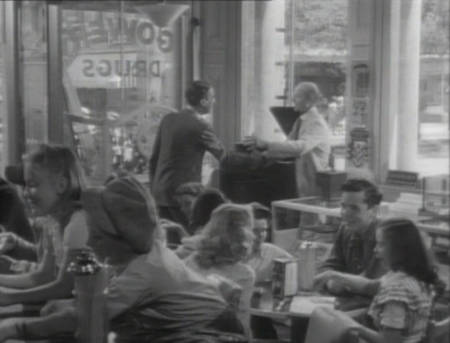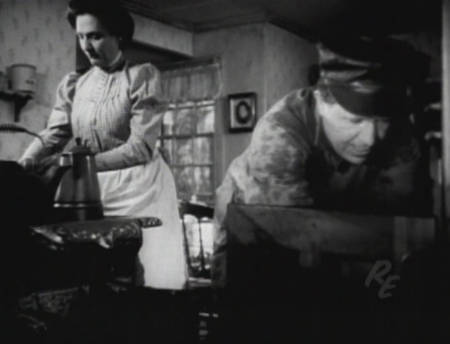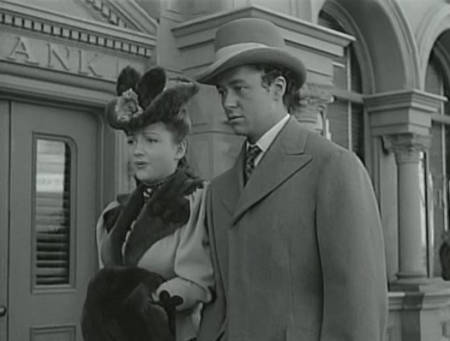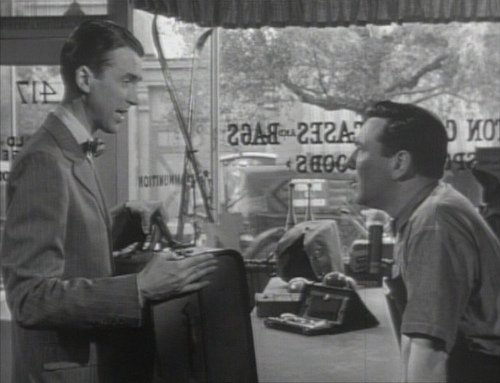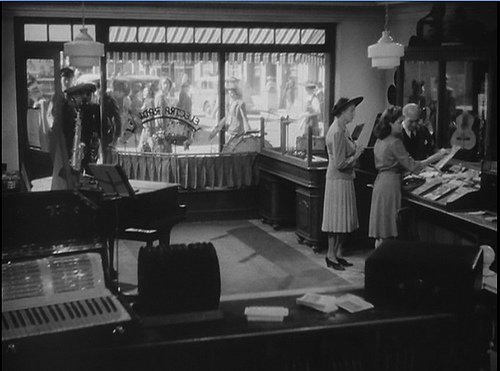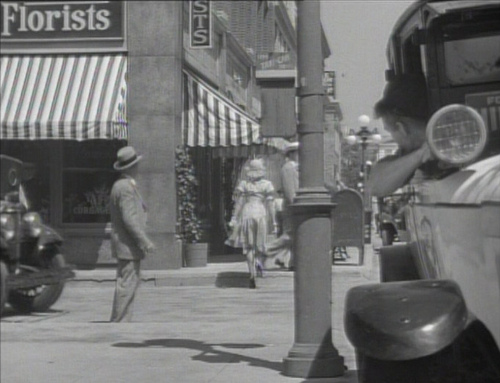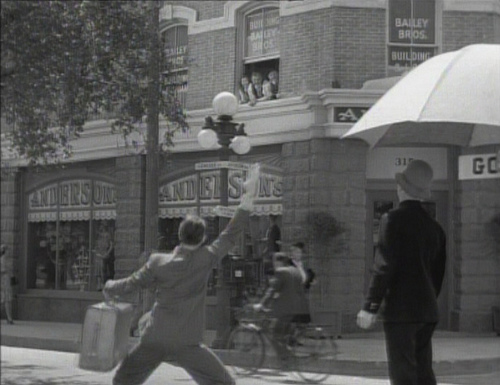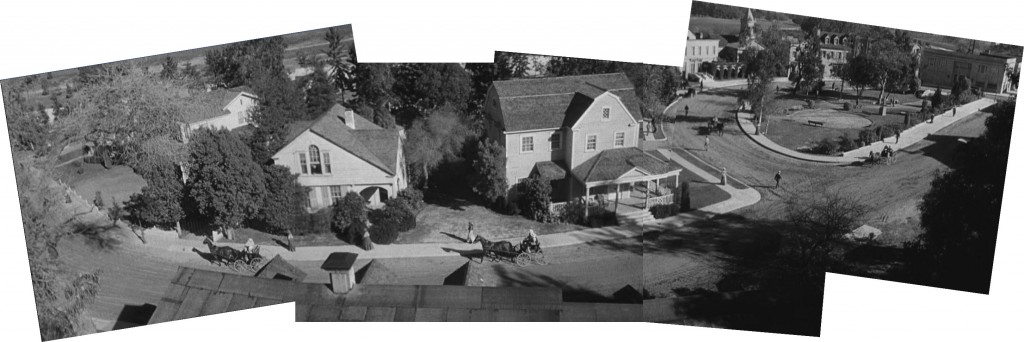 This article first appeared in the online journal Refractory – direct link here. In the version here I have added clickable images – you can click on any image to go through to flickr where you can see it in a larger format.
This article first appeared in the online journal Refractory – direct link here. In the version here I have added clickable images – you can click on any image to go through to flickr where you can see it in a larger format.
The origins of the modern suburb can be traced back to the mid 19th Century, with streetcars and the railroad spurring the development of commuter suburbs, and industrialisation increasing the urge to escape the pollution and overcrowding of cities and also spurring the creation of company towns for workers.1 The appeal of the suburban ideal is not hard to understand, with urban hinterlands long having been recognised as harbouring the potential to provide the best of urban and rural lifestyles. Ebenezer Howard’s 1898 conception of “three magnets” is a classic expression of this urge, with “town” and “country” each offering a dubious mixed bag of blessings and faults, but “town-country” giving an irresistible blend of both:
Beauty of Nature, Social Opportunity. Fields and Parks of Easy Access. Low Rents, High Wages. Low Rates, Plenty to Do. Low Prices, No Sweating. Field for Enterprise, Flow of Capital. Pure Air and Water, Good Drainage. Bright Homes & Gardens, No Smoke, No Slums. Freedom, Co-operation.2
Howard conceived of stand-alone master-planned garden cities, but the edges of existing cities represented a more readily accessible site to pursue the balance of the space and beauty of the country and the opportunities and society of the city. Yet the mass adoption of the suburbs as a dominant mode for middle-class residential living – rather than as a haven for the extremely wealthy – can be traced to the period immediately after World War II, to the point where the popular conception of suburbia is inextricably linked to the 1950s: the expression “sitcom suburbs” raises an instant image of a particular type of lifestyle, most stereotypically embodied in 1950s sitcoms such as Leave it to Beaver (Gomalco Prodcutions and Kayro-Vue Productions, 1957-1963), The Adventures of Ozzie and Harriet (Stage Five Productions, 1952-1966), and Father Knows Best (CBS, NBC and ABC, 1954-1960).3 At the conclusion of World War II, a number of factors combined to lead to the mass expansion of suburbs in the United States and Australia (and to a lesser extent in Europe and the United Kingdom). Without war and depression to stifle growth, automobiles could realise their latent potential to reshape the built landscape;4 mass production reduced construction costs, with home construction shifting sharply away from owner-builders to developer-builders;5 and affordability was artificially spurred by direct and indirect government subsidies for suburban development, including highway construction and direct financial assistance such as the United States’ Serviceman’s Readjustment Act of 1944.6 With suburbia more accessible than ever before, populations eager to realise the hard-won fruits of victory (and in the midst of a post-war baby boom) flocked to suburban communities. Between 1950 and 1970, central cities in the United States grew by 10 million people, but their suburbs added 85 million.7 The paradox created by this mass adoption of the suburban lifestyle was quickly recognised, and has been much discussed since: the scale of the suburban roll-out meant that the original “best-of-both worlds” ideal was quickly extinguished. Road networks became increasingly extravagant even as they became ever-more congested; the dispersal of uses meant the urban environment became vast and centreless; the mass-production of houses led to dull and lifeless street environments; and the actual urban / rural interface continually leap-frogged each new ring of development, stripping communities of the access to open landscape they had previously enjoyed. Such problems were quickly apparent: as urban historian Lewis Mumford noted in 1961, “[a]s soon as the suburban pattern became universal, the virtues it at first had boasted began to disappear.”8 Yet despite this prompt identification of the perils of suburban development, the continued popularity of the model attests to the powerful pull of the suburban dream. If anything, disappointment in actual suburbs only strengthens the urge to find that elusive community that can approximate the imaginary ideal of community, spaciousness, and aesthetic appeal. These are essentially the qualities associated with the quintessential small town, to the point where the imagined virtues of suburb and small town are inextricably linked: suburbs are an attempt to mass-produce an affordable version of the perfect small community. It is therefore of interest to look at the ideal of the small town as depicted in Hollywood films at the dawn of the suburban explosion. These have much to tell us about the community ideals that drove post-World War II suburban expansion.
As Rob Lapsley has noted, “[i]t has become a cliché of contemporary writing that the city is constructed as much by images and representations as by the built environment, demographic shifts and patterns of capital investment.”9 As is often the case, this notion has become a cliché because of its common-sense usefulness and intuitive correctness: it is easy to appreciate how our mental conception of a place such as New York City is shaped by its frequent depiction in film, television and literature. However, the importance of representation becomes even more important when one considers the case of notional places: representations that we use to define and describe a general category of place (eg “suburbia,” “small town,” “big city,” “Main Street”). In these cases, there is no single real-world referent, and so the overlay of multiple depictions of such communities becomes all-important. Our idea of the small town is, as Kenneth MacKinnon puts it, “an amalgam of elements much less to do with actual American small towns than with manifold literary descriptions and repeated cinematic treatments.”10 Such depictions are of interest because, as MacKinnon argues, the imaginary small town is a “storehouse of American values” and as such a study of the depiction of them is a means of exploring the nation’s psyche; the ubiquity of Hollywood entertainment means that these then have wider international currency.11 In the current context, it is the ideals of community enshrined in Hollywood’s depictions of the small town that are of interest. In this article I will therefore examine the depictions of small towns in a number of Hollywood films from the 1940s, to attempt to describe some of the ideals of community that were shaping (and reflecting) the community attitudes that would underlie the post-war suburban boom. Two points are of particular interest. Firstly, what are some of the common physical and social characteristics of the communities as depicted in these films? And secondly, what can we glean from the films about the attitudes to community and suburbanisation that existed at the dawn of the suburban age?
Two films are of particular interest in framing this discussion. The first is Our Town (Sam Wood, 1940), based on Thornton Wilder’s play from 1938. As both MacKinnon and Eugene Levy argue in their respective studies of small town films, the 1930s saw a proliferation of particularly sympathetic portrayals of small-town life, with the Depression prompting a romanticisation of traditional values and rural lifestyles in response to the perceived failure of urbanisation and industrialisation.12 Wilder’s play, which won a Pulitzer Prize, appeared towards the end of this cycle of works and its film adaptation appeared at the start of the 1940s sequence of small town films. The film therefore represents a very useful starting point, as a work that makes a determined claim to a status as a definitive depiction. Our Town’s deliberate authoritativeness is marked by many factors: the title; its omniscient birds-eye narration; the focus on typical “day-in-the-life” goings-on; the humorously ultra-rational account of the town’s geographical and anthropological history; the narration’s insistence on the town as representative of many others; and the decade-spanning storyline. Equally interesting is It’s a Wonderful Life (Frank Capra, 1946), which has a strikingly similar sense of summation: it has been described variously as both a “culminating work” for Capra, and as an “ideological summation of an era” in Levy’s study of small town films.13 Whether by coincidence or design Capra’s film repeats many specific motifs from Our Town: the omniscient point of view, with the narrator manipulating the “playback” of events; characters who are resistant to embracing the commitments of domestic life; divine intervention allowing someone to view and reappraise their own life from the outside; and the climactic expression of a will to live. It also shares the earlier film’s strong thematic emphasis on the positives and negatives of small town life. Capra’s film, as will be discussed, is unusually explicit in its consideration not only of the attractions of small town life versus big city life, but also of its hero as a potential developer / urban planner (George Bailey declares he wants to “build things, design new buildings, plan modern cities”) whose actions shape a particularly malleable urban environment. It’s a Wonderful Life is also of note as the most widely revived and remembered of the 1940s small town films, due to the ongoing popularity of its star and director, and its status as a seasonal “standard.”14 Its vision of the small town therefore remains one of the most culturally pervasive of Hollywood’s depictions. Turning to the questions posed above, we find that in both these films, and the other films considered – The Magnificent Ambersons (Orson Welles, 1942), Kings Row (Sam Wood, 1942), Shadow of a Doubt (Alfred Hitchcock, 1943), Meet Me in St Louis (Vincente Minelli, 1944), and The Miracle of Morgan’s Creek (Preston Sturges, 1944) – there is a high degree of consistency in the physical and social landscape of the imagined small town. Interestingly, however, the thematic approach to notions of community suggests a great deal of anxiety about such communities both in their historic form as small towns, and also as a model for future communities.
The Physical and Social Properties of Hollywood’s Small Towns
The recurring features of the depicted communities in Our Town and the other small town movies cited can be summarised as follows:
- A distinct retail and social hub (particularly a Main Street).
- Institutions prominently present in social hierarchies and architectural design.
- Locally owned and socially integrated businesses.
- Predominance of classical forms of architecture.
- Fluid interface between the public and private realm.
- A walkable community (compact physically).
- An intimate and well connected community (compact socially).
- A close link between town and country.
- Family units as the essential building blocks of the community.
- A population that has a multi-generational link with the community.
- De-emphasis of cars and emphasis on various forms of non-car transport.
- A period setting, or a sense of the place being “out of time.”
These points will be explained further and elaborated upon below.
A Distinct Retail and Social Hub (Particularly a Main Street)
“Running right through the middle of the town is Main Street,” declares the narrator, the druggist Mr Morgan, at the opening of Our Town.15 The idea of a strongly defined commercial and social hub, usually in the form of a central shopping street but also present in other forms, such as a town square, is integrally associated with conceptions of small towns. “Main Street” can be identified and studied as a distinct notional place in itself, as historical geographer Richard Francaviglia has, notably in his book Main Street Revisited: Time Space and Image Building in Small-Town America. Francaviglia studies the role that various actual Main Streets play in real communities, as well as the influence of artificial Main Streets in literature, film, and historical / theme park recreations. Francaviglia notes the way in which Main Street becomes an icon closely equivalent to small towns themselves, and in particular one associated with nostalgia for small town life:
As it evolved in time and space, Main Street became the commercial and social heart of the American small town; as it developed in our collective thought, Main Street became an integral part of American culture. Because many people left small towns in the early to mid-twentieth century, these places became repositories of memories.16
The Main Street is both a key ingredient in conceptions of the small town (as its commercial and social heart), and also as an iconic – in the semiotic sense of a part that stands for the whole – representation of the town.17 In a design sense, too, Main Street also serves an important function in underlining the presence of a geographically centred community: this is not the dispersed, placeless built form of the suburbs. Main Street’s power as a signifier increases as real Main Streets become less familiar due to the populations leaving small towns (as Francavaglia suggests) and also as real examples become less common, displaced by other modes of retailing such as stand-alone car-oriented malls, “big box” retailing and highway-side shopping strips. The depiction of Main Street in these 1940s examples therefore deserves a particularly detailed consideration.
In Our Town, we see relatively little of Grover’s Corner’s Main Street, despite its prominent name-check in the opening lines of dialogue; the focus in this film is much more firmly on residential areas. Where Thornton Wilder’s stage play stipulated that no scenery should be used (strengthening the idea of Grover’s Corners as a generic and imagined place rather than a specific locale),18 the film uses relatively elaborate backlot sets, but these are predominantly of houses and residential streets. Main Street is vaguely suggested in the distant aerial view of the town at the opening of the film, and there is one Main Street set: a shopfront for Morgan’s drug store, which we see most prominently as Morgan hosts us a scientific account of the town (from a professor and the town’s newspaper editor) and then later (from the interior) when it is the setting for the young couple Emily and George to discuss their future. In the discussion with the newspaper editor, the editor leans out of the upper storey window, but we see nothing else of the facade: this economising with sets means Our Town’s notional Main Street is largely constructed through editing and imagination rather than an actual physical construction or a visual depiction. The editing of the conversation between the druggist and newspaper editor establishes that these two important commercial enterprises are within extremely close proximity, but otherwise we see little of the physical setting of the Main Street. What we do see, however, establishes the sense of the street as an “old-fashioned” space: a few brief shots establish that the drug store’s Victorian shopfront is in extremely close proximity to the un-made street surface, behind large trees, and with a pitching post for horses in front (figure 1a). This latter point reflects Morgan’s dialogue at the start of the film describing the town in June, 1901: “Along Main Street there’s a row of stores with hitching posts and horse blocks in front of ’em. The first automobile is going to come along in about five years.” A later shot (figure 1b), as George and Emily enter the drug store, lets us see from the interior to the exterior: this shot shows us the prevailing Victorian architecture, and implies through the orientation of visible buildings that the drug store (and hence the newspaper building) actually faces an unseen town square. (The town square is the other prominent model for a community hub and serves essentially the same role as Main Street in films; however, it is somewhat less common and appears comparatively fleetingly in the films examined for this article).19
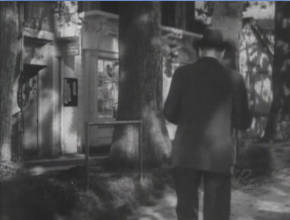 |
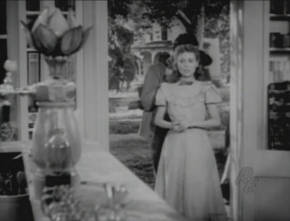 |
|
Fig 1a |
Fig 1b |
|
Drugstore Interior and Exterior, Our Town |
|
Similarly curtailed views of Main Street are found in the predominantly residentially-set Kings Row, The Magnificent Ambersons, and Meet Me in St. Louis. In Kings Row we see Main Street only in one scene, when Drake McHugh visits the bank: while only briefly seen, it is attractive and well populated, with a wide median (figure 16a) and a monument prominently erected at the centre of the street. In The Magnificent Ambersons Main Street is present through several long shots (see, for example, figure 5) and in close-up as George Minafer and Lucy Morgan discuss their estrangement; while the close-up scenes in particular give a sense of it as busy, there is little sense of Main Street as a distinct place in Welles’ film. Similarly, Meet Me in St. Louis features one scene – its most famous, the Trolley Song scene – on a Main Street that is shown most clearly through a brief scene at the trolley depot as the passengers gather to board the trolley, and then through largely obscured back-projection. Nevertheless, despite its brief appearance, the Main Street we see is clearly prosperous, with well-kept shopfronts and wide streets.20 Compared to these period films (all set around the turn of the century), Alfred Hitchcock’s Shadow of a Doubt makes an interesting comparison: like Meet Me in St Louis, it presents a cosy image of a small town through its depiction of leafy tree-lined streets with grand housing. However, its Main Street is the odd one out in the films studied here, being the only one that is both set at the date of production (1943) and also shot on real streets, in the actual town – named in the film – of Santa Rosa, California.21 Its street scenes (see figures 2a – 2d) are notable for a number of factors: unsurprisingly given the use of real streets, there is a strong sense of verisimilitude in its street scenes, and the streets are noticeably busier than in the other examples, in some shots feeling decidedly urban in their character. The establishing shot of Santa Rosa (figure 2a) gives a sense of the clash of small town versus urban iconography. Urban elements include the crowdedness of the streets, dominance of cars, and the subservience of pedestrians to vehicle traffic: pedestrians cross as directed by traffic police. However, there are also still comforting elements of the small town community in this shot: the classically inspired architecture, prominent civic buildings, the inviting streetscape element of the verandah framing the shot, and the reassuring presence of the local policeman (who is picked out through close-ups at several points through the film). Later, as Charlie and her uncle walk to the bank, we get a brief shot of a town square fronted by civic buildings (figure 2b) and a long view of the streetscape showing a street level vibrancy but also urban elements such as the high billboard style signage visible in the background and a disproportionately wide vehicle carriageway (figure 2c). An early shot showing the family driving to the station to pick up Uncle Charlie (figure 2d) underlines the sense of a small town teetering on the edge of urbanisation: this shot – which pans right to reveal the railroad station – gives a strong sense of the size of the town, with the railroad station apparently on the town’s fringe and a Main Street receding to a town centre distantly visible in the background. It should be noted that all these elements are contextualised by their contrast with particularly seedy urbanism (see figure 18) earlier in the film and the aforementioned attractiveness of the residential precincts; furthermore, Dimitri Tiomkin’s jaunty musical cues emphasise the positive aspects (vibrancy, excitement) of the Main Street rather than any negative connotations. The predominant view is therefore still of a Main Street that represents a social hub and civic centre, rather than a degenerated, urban style “downtown.”
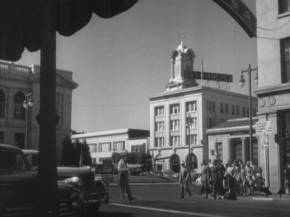 |
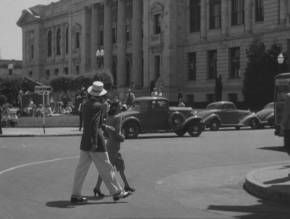 |
|
Figure 2a |
Figure 2b |
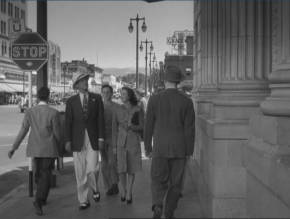 |
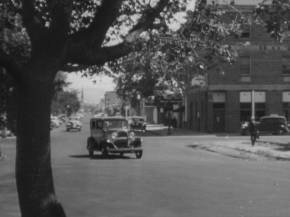 |
|
Figure 2c |
Figure 2d |
|
Main Street, Shadow of a Doubt |
|
Preston Sturges’ wartime comedy The Miracle of Morgan’s Creek also depicts a noticeably bustling town centre, although here Sturges’ intent is humorous, emphasising the way the town has been overrun by soldiers and (through his consistently busy compositions) creating a general sense of comic hubbub. Sturges, however, was using a back lot: his town is Paramount’s back lot street set, which had been used in other films during the 1930s, and (probably apocryphal) accounts suggest Sturges wrote the film partly to save the set from demolition.22 While Sturges’ approach to the material is aggressively comedic and subversive in tone (with its emphasis on scandal and its provocative plot about an unmarried mother), the film is notable for the loving attention it gives the small town environment. Sturges stages several long dialogue scenes that unfold over extended tracking shots that follow characters through the backlot set, and these scenes are rich in detail of Morgan Creek’s Street Life. A particularly good example occurs as Trudy and Emmy Kockenlocker discuss Trudy’s scandalous pregnancy while walking through the centre of town. In one lengthy shot, the camera follows the pair from the lawyer’s office, past a series of wooden buildings that would not look out of place on a western set (figure 3a), attractive shopfronts, a miniature town square consisting of a planted median with seating and a small rotunda, and more substantial brick buildings. As they walk, the pair pass various bits of small-town “colour:” a street vendor (figure 3b), shoe-shiner (figure 3c), a policeman chatting to an attractive woman, and a street cleaner (the last three figures all in figure 3c). Despite Sturges’ satirical tone throughout the film, the overwhelming impression in its presentation of the Main Street is of a vibrant, functional community hub.
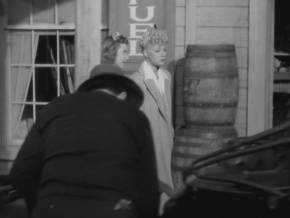 |
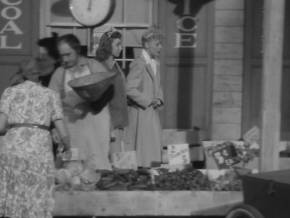 |
|
Fig 3a |
Fig 3b |
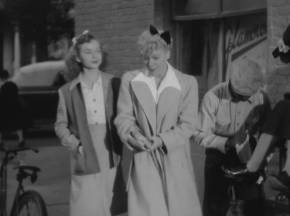 |
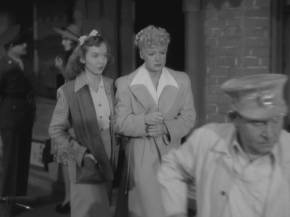 |
|
Fig 3c |
Fig 3d |
|
Street Activity Details, The Miracle of Morgan’s Creek |
|
Frank Capra’s It’s a Wonderful Life – probably the best-remembered of the mid-twentieth century depictions of small town life – offers a similarly rich back lot Main Street. The film was shot on a three block long purpose-built set on RKO’s ranch in Encino, California.23 The Main Street (Genesee Street) is shown at various time periods: first in 1919; then prominently shown again as it exist in the late 1920s and early 1930s; and finally as it exists in 1945. (It also appears as “Pottersville,” an alternate urbanised version of the town, in the fantasy sequence, but the implications of this form of the street will be discussed later.) We are first shown the street in the flashback to 1919, when the young George Bailey is working at the drugstore: as in Our Town, the drugstore is shown as a centre for socialising where sodas, milkshakes and sundaes are enjoyed, and romances blossom. Later, in the 1928 sequence, the drugstore is shown as particularly busy and well-patronised (figure 7). The street itself is wide, bound by one and (predominantly) two storey buildings, generally of loosely Victorian appearance, along each side. It has an avenue of established trees along the centre, with seating installed (figure 4a); this recalls both the two-lane avenue seen in Kings Row (figure 16a) and the similar centre-of-the-street seating shown in The Miracle of Morgan’s Creek. While cars are present on the street in all the sequences, the street remains a pedestrian dominated space: in the first shot of the street, George and his friends hold up a car by linking arms as they walk along the street (figure 4a), and in other scenes characters freely walk along the roadway (figure 4b). Capra sets enough action on the street, and frames enough of his shots to prominently feature the businesses in the background, that it is possible establish the tenancies for most of the three-block set. As reconstructed by Michael Willian, on one side the street features the sporting goods store (where George Bailey picks up his bag at the start of the 1928 sequence), an antique shop, a bakery, “Bedford House” (presumably a boarding house), a florist / beauty shop, barber, telegram office, emporium, bank dance academy, a café, and library. The other side of the street features a candy shop, art store, music store, theatre, Gower’s drug store, The Bailey Building and Loan, a butcher, newspapers office, tailors, bicycle shop, garage, and a bowling alley/pool hall. At one end Genesee Street is terminated by a cross-street, which features civic buildings, such as the courthouse (which faces up Geneesee Street), gas company, telephone exchange and police station.24 The intersection of these two streets is marked by a monument and a small circular garden that transforms this into a miniature town square (figures 4c and 4d; these are part of the same shot, with the camera panning left from the frame 4c to that at 4d). The basic layout of a circular ceremonial garden within a street intersection is very close to the circle-in-a-square “Philadelphia” plans used in some real American towns, and which was later an inspiration for the layout of Disneyland’s Main Street USA.25 This end of the street also houses the library building on the opposite corner, and its role as a civic precinct is underlined by its use as the setting for the Homecoming celebration in honour of Harry Bailey. The street therefore is shown to include both a bustling retail precinct and a more ceremonial civic area: while viewers of the film are unlikely to put together this geography of while watching the film, the overall effect of this attention to detail is a remarkably convincing portrait of a functioning and attractive town centre.
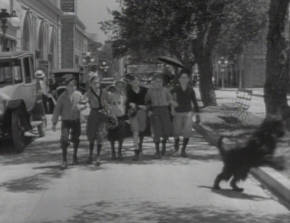 |
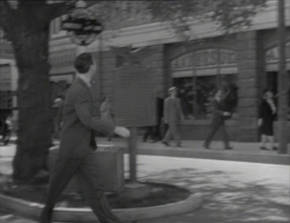 |
|
Figure 4a |
Figure 4b |
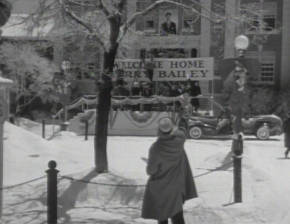 |
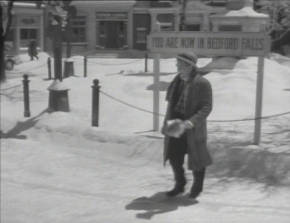 |
|
Figure 4c |
Figure 4d |
Genesee Street details, It’s a Wonderful Life
It is especially interesting to compare Capra’s Bedford Falls with Hitchcock’s Santa Rosa from Shadow of a Doubt. Hitchcock’s film, as noted, presents a particularly realistic Main Street: the buildings and streets are genuine, and in many of the longer shots, it seems likely that much of the background action consists of genuine passers by (since some shots, such as that in figure 2c, would have required closing multiple city blocks if the production had attempted to control the entire street). There is therefore an almost documentary-like sense of realism in these street scenes, and to some extent the realism cuts against the portrait of Santa Rosa as a sleepy haven of old-fashioned values that is established in the rest of the film. In Capra’s film, there is enormous attention to the layout of the town, with a great deal of set detailing and background action dedicated to selling the community as real. At the same time, however, that extent of stage-managing allows the town to be unfailingly picturesque (excepting, obviously, the Pottersville scenes), and through design and necessity the street and buildings are of a more intimate scale than Santa Rosa streets (compare the street in figure 4a with that in figure 2c, or the square and courthouse in figure 4c with that in figure 2b). The resultant street scenes create an imaginary town that in many ways is more persuasive, and with more distinctive character as distinct “place,” than Hitchcock’s more reality-based Santa Rosa Main Street. It’s a Wonderful Life (and, to a lesser extent, The Miracle of Morgan’s Creek) emphasise the ability of a fully controlled back-lot set to create a “realer-than-real,” archetypal environment. In his study of classical Hollywood set design, Juan Antonio Ramírez quotes production designer William Cameron Menzies on this idea:
…if, for example, you film a romantic place [on location] like a picturesque European street, you can achieve an exact reproduction – but that will still be minus the atmosphere, texture, and colour. So it’s always better to replace it with a set [erected in the studio] which gives the impression of the street, as it exists in your mind, slightly romanticized, simplified, and overly textured.26
It’s a Wonderful Life’s Genesee Street is a particularly compelling example of this principle; it as at once so attractive and persuasive – so full of “atmosphere, texture and colour” – that it approaches the ideal of what architect Paul Goldberger (speaking of Disneyland’s Main Street USA) has called a “universally true” Main Street.27
Institutions Prominently Present in Social Hierarchies and Architectural Design
The presence of a prominent civic precinct (comprising courthouse, library, police station and utility buldings) in Bedford Falls raises the importance of civic and religious institutions and their buildings in the archetypal small town. This is emphasised by the Morgan’s description of Grover’s Corners at the start of Our Town:
Running right through the middle of the town is Main Street. Cutting across Main Street on the left is the railroad tracks. Beyond the railroad tracks is Polish town; you know, foreign folks who come here to work in the mills, a couple of Canuck families, and the Catholic church. You can see the steeple of the Congregational church; the Presbyterian is just across the street. The Methodist and the Unitarian are up a block. The Baptist church is down in the hollow, by the river. Next to the post office is the town hall. Jail’s in the basement. [William Jennings] Bryan once made a speech right from those very steps. It’s a nice town, know what I mean?
This succinct description of the layout of the town as anchored by its civic facilities (post office, town hall, jail, railway station) and religious institutions (six churches, four specifically identified as within about a block of each other near the centre of town) emphasises the importance of such institutions in framing the community. The prominent role of religious institutions on this list is notable for reinforcing the emphasis on traditional and conservative values (we later learn the town is 86% Republican), and would be of interest to critics focussing on Althusserian notions of the role institutions play in perpetuating ideological frameworks.28 This is not, however, my focus here. The presence and proximity of all these institutions (religious and civic) is instead of interest primarily for their role as centres of community engagement and participation. Decreased involvement in community activities is an often-cited failure of the retreat to dispersed, privatised suburban lifestyles: as Mumford put it in 1938 – co-incidentally the same year Wilder’s play was published – suburbs represent “a collective effort to live a private life.”29 Intriguingly, while declining community participation is often identified as a post-1950s (and hence post suburbia, post-television) phenomenon, Robert D. Putnam’s study of community engagement suggests many measures of social participation – church attendance, for example, as well as membership in chapter based associations, the PTA, unions, and professional associations – showed similar slumps also occurred during the 1930s, as communities were buffeted by the Depression, before rising again in the 1940s and then dropping away again after the 1950s.30 This suggests that there may have been some recent impetus for nostalgia for the participatory communities of earlier days even in the early 1940s, and particularly in 1938 when Our Town first appeared as a play. Regardless of the cause for such nostalgia, a strongly defined and localised presence of civic institutions is a meaning-laden trait of the archetypal small town, symbolising a close-knit community and a strong social order.
As suggested by the above monologue, the church plays a particularly strong role in Our Town. The wedding of George Gibbs and Emily Webb is a central sequence, and the church is one of the few non-residential buildings we see in Grover’s Corners. The church is also a centre of socialising and gossip; a subplot concerns the interest of the town’s women in the drinking problem of the church organist, and his eventual suicide. The context in which the church appears reinforces my suggestion that it is less important, here, as a source of religious and moral guidance (the drunkenness of the organist and the uncompassionate response of the townsfolk make that clear). Instead, the church acts as a source of community cohesion, both as a gathering place for socialising and as the socially sanctioned means for couples to form unions. Where in daily urban and suburban life it is increasingly common for socialising to be centred on the workplace, in Our Town we never see any characters’ place of employment, with a few very telling exceptions: Morgan is shown at work in his drugstore, but this is itself a community hub; we see the newspaper office only from the street, a place of public interaction; and we see several characters – the newspaper boy and the milkman – whose workplace is the street.31 The other films studied for this article share this de-emphasis of places of workplace socialising in favour of concentrating on the institutions that define the town physically and socially. In Miracle of Morgan’s Creek we see community celebrations in the church basement and at the country club. A similar party occurs at the local high school in It’s a Wonderful Life where George and Mary start their romance. Those people we see at their place of employment are usually involved in enterprises that are involved one way or other in linking or building the community: newspaper offices are shown in Miracle of Morgan’s Creek and, as mentioned, externally in Our Town; and we see a lawyer’s office in Kings Row and Miracle of Morgan’s Creek. (The father in Meet Me in St. Louis is also a lawyer, but we never see his workplace, in accordance with the film’s extremely strong focus on the domestic sphere). Banks also figure prominently: the family patriarch is employed at a bank in It’s a Wonderful Life and Shadow of a Doubt, as is the aspirational patriarch Norval in Miracle of Morgan’s Creek; scenes take place in the bank in all three films. Drake McHugh also visits the towns’ bank in Kings Row; the plot-line in which he is ruined by a bank scandal and turns to property development anticipates It’s a Wonderful Life, and both films emphasise the importance of the bank in the welfare of the community.
The importance of all these community institutions is emphasised by their prominent featuring in the films and their close physical integration into the fabric of the town. As noted, the geography of Grover’s Corners in Our Town is laid out in terms of the location of churches and other civic buildings. We later see a shot of an impressive schoolhouse, standing on what seems to be a hill outside of town; likewise the opening shots of Kings Row show us that town’s school. Banks have prominent positions on the Main Streets in It’s a Wonderful Life, Kings Row, Shadow of a Doubt and The Magnificent Ambersons (in which it is one of the only Main Street buildings we clearly see – although a long shot also shows a prominent civic building, probably a town hall, facing down the street, see figure 5). Shadow of a Doubt’s streetscape also features what is probably a town hall (figure 2b), and the town has a particularly attractive ivy-covered public library. As already discussed, It’s a Wonderful Life’s Genesee Street terminates in a town hall and a miniature civic precinct; in a similar fashion, the Main Street in The Miracle of Morgan’s Creek terminates in the newspaper building and a fire station (figure 6). In Hail the Conquering Hero, made by Sturges in the same year and using the same Main Street set, a church sits in this position.[32]
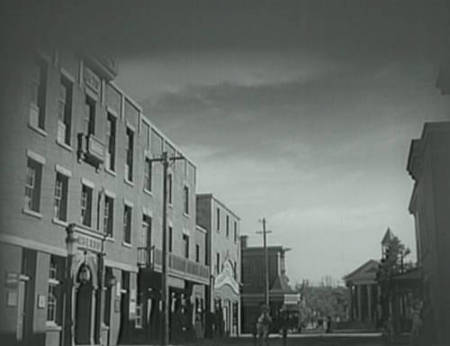 Figure 5 – Main Street, The Magnificent Ambersons
Figure 5 – Main Street, The Magnificent Ambersons
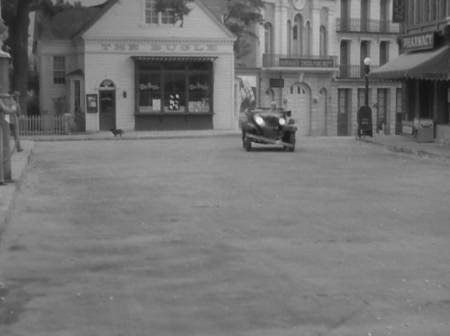 Figure 6 – Main Street, The Miracle of Morgan’s Creek
Figure 6 – Main Street, The Miracle of Morgan’s Creek
Locally Owned and Socially Integrated Businesses
I have already noted the prominence of the drugstore as a social centre in both Our Town and It’s a Wonderful Life. The drugstore takes the role for meeting and socialising that might be fulfilled by either a coffee shop or a bar in more recent films, but without the negative connotations of the somewhat seedy bars we see in the Pottersville sequence of It’s a Wonderful Life, or in Shadow of a Doubt. Indeed, as Nezar AlSayyad points out, the drugstore is notable in the film as a social space that brings children and adults together.33 It is a safe, socially acceptable place for boys and girls to meet and thus be initiated into the social rituals of courtship and dating: it is in the drugstore that Mary and Violet first compete for the attention of George Bailey, and in Our Town it is in the drugstore that George Gibbs and Emily Webb discuss their future. In It’s a Wonderful Life, particularly, the drugstore is seen as a bustling, wildly popular venue for young and old alike, with people crammed around tables and at piled up at the bar (see figure 7). Crucially, both druggists are known by name – Morgan in Our Town, Gower in It’s a Wonderful Life – and are seen to be well-recognised by the townsfolk. They also know their customers well, to the point where Morgan doesn’t hesitate to let George leave the store without paying for his drinks. (Even when George offers to leave his watch as surety and come back with the money in five minutes, Morgan insists that won’t be necessary: “I’ll trust you for ten years.”) This kind of one-on-one relationship with local retailers recurs throughout the small town films studied, and stands in contrast to most modern experience of retailing. Shops are shown as locally owned, by a recognisable storekeeper, as opposed to the multi-national or chain branding that dominates retailing today. Where retail signage in modern shopping centres tends to identify only an established brand, which is trusted to communicate function (eg “Borders,” not “Borders Books”), signage on the depicted Main Streets is overwhelmingly directed to identifying an owner’s name and the store’s function: hence along Genesee Street we have Gower Drugs (visible in figure 7), Peterson’s Tailer Shop, Violet’s Beauty Shop, Jenkins Art Store, and so on. (An example of such signage from The Magnificent Ambersons can be seen in figure 9, and function-only signage – “Pharmacy” – is visible in figure 6, from Miracle of Morgan’s Creek).
Figure 7 – Drugstore as a social centre in It’s a Wonderful Life.
This identification of owners is one example of the way in which business owners are integrated into, and well known by, the community. So in Shadow of a Doubt the whole family knows Mrs Henderson from the postal union office; while in The Miracle of Morgan’s Creek a passerby knows that the soldiers will be able to find the attractive – and, it is implied, available and promiscuous – Trudy Kockenlocker at the music store. The passer-by also knows that Trudy is the policeman’s daughter. In It’s a Wonderful Life, George Bailey has a strong personal relationship not only with Gower the druggist but also the owner of the luggage store, and bar-owner Martini. George also has a close relationship with his customers at the Bailey Building and Loan. The whole film turns on this point, when at the conclusion many of his customers come to his aid, but George’s close relationship is demonstrated earlier in the film by the way he addresses them when there is a run on deposits: as he pleads with customers not to panic and sink the business, he refers by name to “Charlie,” “Joe,” “Randall,” “Ed,” “Tom,” “Mrs Thompson,” and “Mrs Davis” (as well as the houses belonging to “Mrs Maitland” and “The Kennedys”) and can cite details of their individual financial circumstances. He also echoes Morgan’s actions in Our Town by not asking for paperwork as he gives out loans from his own money: “You don’t have to sign anything; I know you, you pay it when you can, that’s okay.” Even Bailey’s rival Potter, the symbol in the film of the hard-nosed and uncaring businessman, is well known to the community (although he makes a point of not knowing them).
Another striking example of social integration of local business people is seen by the various figures whose place of business is the street and the home. This is most striking in Our Town, where in the opening minutes we are introduced to Joe Crowell delivering the papers, Howie Newsome the milkman, and Doc Gibbs returning from a house-call to deliver twins. The doctor chats to both Crowell and Newsome, exchanging community news (the marriage of Joe’s teacher, the birth of the Polish twins) with each. Howie Newsome’s relationship with his customers is shown as particularly intimate: his horse stops out of habit at particular houses even after they have ceased delivery, and Howie enters the houses of his customers (whom he addresses by name) to place milk directly into their iceboxes (figure 8). In Meet Me in St. Louis, Mr Neely the ice man has the same problem with his horse having memorised his route, and knows the family well enough to take the 5-year-old Tootie along on his deliveries. In addition to Doc Gibbs in Our Town, doctors are also shown making house calls in Meet Me in St. Louis and in Kings Row. As in Our Town, the various doctors we see in Kings Row (Dr Gordon, Dr Tower, and in the latter parts of the film Parris Mitchell) are seen as deeply embedded in the social fabric of the town, with the good Mitchell and Dr Tower fighting the corrupting influence of the malignant Dr Gordon. In It’s a Wonderful Life we get further prominent examples of the on-street community with Bert the policeman and Ernie the cab driver, both of whom know George Bailey by name and who collaborate on the staging of his romantic wedding night. All these figures contribute to the sense of a residential population closely interweaved socially with the community’s businesses, and where socialising occurs in business spaces and business occurs in social spaces.
Figure 8 – Deliveries to the icebox in Our Town.
Predominance of Classical Forms of Architecture
The architecture of the depicted small towns emphasises stability and traditional values. On Main Street, that takes the form of a domination of Victorian architectural styles, particularly more formal designs such as eleborate Italianate shopfronts, or classically inspired civic buildings (figures 2 and 5). Richard Francavaglia notes that in the United States shopfront design “came of age” in the mid 1840s to 1850s, with increased mobility allowing increased awareness of European design styles, and improved technology (plate glass) allowing much larger windows for the display of goods.34 He argues that the emergence of this style at this time then solidified a more unified, formal style on typical Main Streets:
Whereas many earlier (pre 1850) buildings on Main Street were vernacular in design and a few reflected high styling, things changed rapidly when trained architects entered the picture. Most new buildings on Main Street were now likely to be formal in style and more standardized in construction, for high-style fads or trends were promoted in journals and magazines that became commonplace after about 1870. By the mid-nineteenth century, Victorian Italianate and Gothic styling influenced all types of buildings – residential, institutional, and commercial. Victorian styles superseded earlier styles such as the Greek Revival by the late 1860s, and the 1870s witnessed the nearly complete acceptance of Victorian styling for commercial architecture… It is this wholesale acceptance of Italianate commercial style architecture that gives Main Street such a recognizable identity by the late nineteenth century.35
The ubiquity of the Victorian shopfront on real American Main Streets was increased by the retrofitting in the late nineteenth century of earlier buildings with catalogue-ordered false shopfronts, and a general standardisation of design sweeping the country during a period of early industrialisation and prosperity. In the films studied there is some diversity with regards to elaboration and materials, but variations of the large-windowed, formally designed Victorian shopfront can be seen throughout the films studied (see figures 1a, 1b, 4b, 6, and 9). In film, the use of such a style obviously simply reflects in part the reality of these constructions, particularly for the examples set at the turn of the century. However – as the real California street landscape of Shadow of a Doubt streetscape seen in figure 2 hints – such street forms were under pressure by the mid twentieth century, as building technologies changed, and as cars altered both the way the street was viewed, and the way it needed to be laid out physically (to allow for parking, vehicle carriageways, and the like).[36] The dominance of particularly fine examples of such streetscapes therefore carries an element of nostalgia and reassurance. It should also be noted that in the case of the back lot streets in Our Town, The Miracle of Morgan’s Creek, and It’s a Wonderful Life, the Victorian shopfront has a pragmatic advantage in that the style is based on a dominant facade that conceals the roof form behind, and which is constructed boundary-to-boundary: this makes it an ideal template for set construction, since only one face of a building generally needs to be built.
Figure 9 – Shopfront with Italianate detailings, from The Magnificent Ambersons.
As Francaviglia notes, such Victorian styling can also be seen in residential architecture in small town films, although here there is more variation: residential precincts are less formalised and more variable spaces than Main Streets. However, most prominent are Victorian and Edwardian examples, with associated architectural adornments such as turrets, dormers, bay windows, canopies, and verandahs (see examples in figure 10).37 Detached family homes are the overwhelmingly favoured housing model, and they also tend to be, by modern standards, extremely spacious: in Meet Me in St. Louis the children complain of having to move to New York and being “cooped up in tenements,” and well they might given the lavish accommodation on evidence in these examples. The houses are usually two storey and set on relatively large grounds, with ample setbacks from the street (although there are exceptions: The Miracle of Morgan’s Creek, for example, shows houses with a more intimate relationship with the street: see figure 11c). Architectural harmony is a consistent feature of the residential areas shown: while there is some variation in architectural styles across examples, there is a general consistency of architectural styles evident on the streetscapes within the examples. This is of note because it shows streetscapes resisting trends away from such stylistic uniformity. In the first half of the twentieth century mass-production of kit houses had eroded the notion of localised architectural traditions, and led to an eclectic variation along streetscapes in emerging suburban communities as owners chose pre-fabricated versions of the traditional styles of their choice.38 Such chaotic streetscapes are not in evidence in the films studied, which evoke earlier patterns of development through their depiction of harmonious streetscapes bound together by a common architectural style. As illustrated in the examples in figure 11, streetscapes are also generally wide, lined by mature trees, with houses having either low timber picket fences or no fences at all. The timber picket fence is significant in marking property boundaries in a manner that does not seek to aggressively exclude the private space beyond from the public realm; indeed, the adoption of the common fencing material means that the fence itself becomes a contribution to the shared streetscape architecture. Exceptions, such as the iron pickets for Dr Tower’s residence in Kings Row or the high front fence for the Ambersons’ mansion in The Magnificent Ambersons, tend to be revealing of character: these are figures who see themselves as above the community, or who wish to keep the community at a distance. Gardens are well tended and attractive. Residential streets are places of activity, with children in particular playing in the street and in the front yards of houses. Together these elements typify an ideal of the residential street that can still be seen in film and television (for example, in the street scenes of a television program such as Desperate Housewives), as an ideal for both small town and suburban streets.
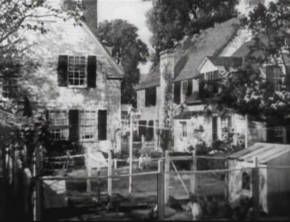 |
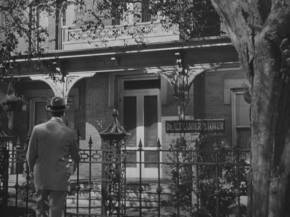 |
|
10a – Our Town |
10b – Kings Row |
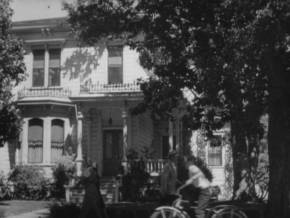 |
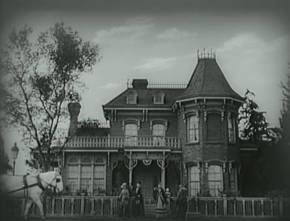 |
|
10c – Shadow of a Doubt |
10d – The Magnificent Ambersons |
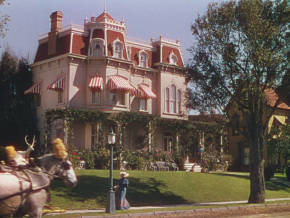 |
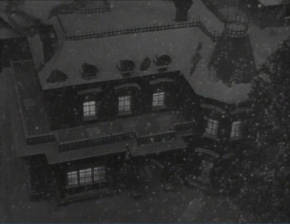 |
|
10e – Meet Me in St. Louis |
10f – It’s a Wonderful Life |
|
Figure 10 – Housing |
|
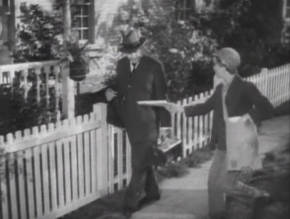 |
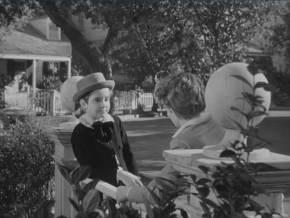 |
|
11a – Our Town |
11b – Kings Row |
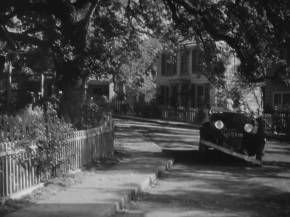 |
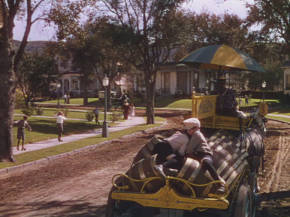 |
|
11c – The Miracle of Morgan’s Creek |
11d – Meet Me In St. Louis |
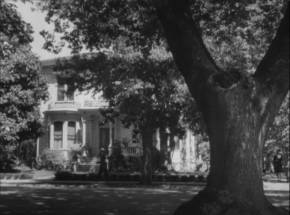 |
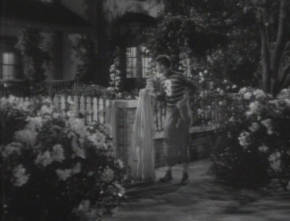 |
|
11e – Shadow of a Doubt |
11f – It’s a Wonderful Life |
|
Figure 11 – Residential Streets |
|
Fluid Interface between the Public and Private Realm
As suggested by the preceding discussion, these small town films show the street as an active and inviting space in both residential and commercial precincts. This is reflected by the way that domestic spaces interact with public spaces; the boundary between the public and realm and private realm is constantly shown as fluid. In the residential sphere, for example, much use is made of transitional spaces such as front yards and verandahs as a setting for action. These spaces (particularly verandahs) are notable for being private, domestic spaces, but ones which are actively conducive to involvement in public life and enjoyment of the activity occurring on the street. In The Miracle of Morgan’s Creek, in particular, Preston Sturges stages a great deal of important action on verandahs: for example, Norval and Trudy discussing their engagement, and Norval’s conversation with Trudy’s father as he cleans his gun. In Meet Me in St. Louis Vincente Minnelli’s fluid camerawork shows the way a party spills between exterior and interior by starting on the verandah (figure 12a) and moving in a single shot through the door into the interior space (figure 12b), underlining the permeable nature of the public / private interface. Earlier in the film we see the potential for verandahs as a social space when Esther and Rose admire their neighbour and attempt to be seen by him (underlining that verandahs are a space for display, as well as simply surveillance; see figure 13). In It’s a Wonderful Life George Bailey discovers the perils of the private surveillance of the public realm when he is heckled by a verandah-bound resident for his clumsy courtship of Mary. Characters are also shown interacting with characters outside their houses from their windows. Most prominently, in Our Town, George Gibbs and Emily Webb talk about their homework from house to house; in other examples, Parris addresses Drake from the street to an upper storey window in Kings Row, as George Bailey does to Mary in It’s a Wonderful Life.
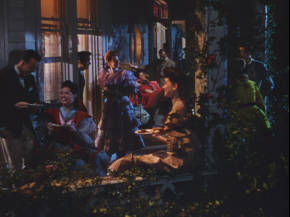 |
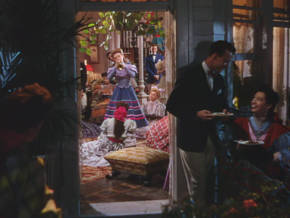 |
|
Figure 12a |
Figure 12b |
|
From exterior to interior, Meet Me in St. Louis |
|
 Figure 13 – Domestic verandah as a space for social display, Meet Me in St. Louis
Figure 13 – Domestic verandah as a space for social display, Meet Me in St. Louis
Commercial buildings show similar traits. As already noted, the Victorian shopfront is characterised by its large window to address the street. While the primary purpose of such a large window is of course for display of goods, it also serves a purpose in linking the interior of shops and offices to the public life occurring out on the street. Given the complications of constructing sets and staging action so that exteriors are visible from the interior, it is conspicuous how much trouble the directors in these films take to stage scenes in a manner that shows the street life occurring outside. Such depictions are sometimes very rudimentary, as in Our Town (figure 1b), but in other cases sets have been deliberately constructed alongside the standing street set to allow interaction between interiors and exteriors. It’s a Wonderful Life’s Genesee Street features three shop sets constructed adjacent to the backlot street: in addition to the drugstore (figure 7) there is also the sporting goods / luggage shop (figure 14) and the bank. The Miracle of Morgan’s Creek also features three interiors with visible exteriors: the music store (figure 15), the newspaper office, and the bank. In Kings Row our best view of the town’s Main Street is through the door of the bank (figure 16a). While in the bank Drake McHugh takes the president’s chair and shows off to Randy Monaghan, thereby explicitly addressing the exterior space (figure 16b). All these scenes highlight the semi-public nature of these interior spaces: the businesses address the street and the spaces along each side of the Main Street become a transitional space that form a continuum with the civic space outside. This reinforces the previously discussed role of the local retailing as part of the community, and their close physical integration on the Main Street (as opposed to a remote, privatised location such as a shopping mall.)
Figure 14 – Shop with visible exterior, It’s a Wonderful Life.
Figure 15 – Music Store, The Miracle of Morgan’s Creek
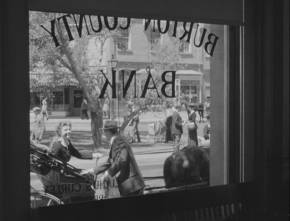 |
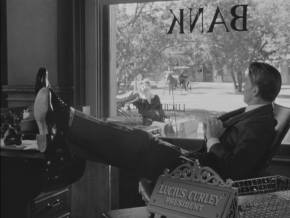 |
|
Figure 16a |
Figure 16b |
Interaction between interior and exterior, Kings Row
A Walkable Community (Compact Physically)
I have already noted the pedestrian friendliness of most Main Streets depicted in these films, the level of street activity evident in residential areas, and the close link between businesses and the community that is evident. All of these factors point to the physical compactness of the towns depicted, in which residents can walk to their friend’s houses, institutions such as churches and schools, and the Main Street. Throughout these films, it is striking how many scenes are staged with characters walking through their community. In Our Town, George walks Emily home, and in another scene to the drugstore. Doc Gibbs walks home from Polish town after delivering twins, and the women of the church choir walk home by themselves after dark. In Kings Row, Drake and Parris first bond over an afternoon spent roaming the town. In Shadow of a Doubt, Charlie and her uncle seem to walk from their home to the bank; Charlie also walks around town with detective Jack Graham. In It’s a Wonderful Life, George and Mary walk home from the school dance. I have already discussed one of the several scenes in The Miracle of Morgan’s Creek where characters walk around town, but another particularly interesting scene is that in which Norval and Trudy walk to the cinema: in one unbroken three minute shot, they go from typical picket-fence residential street (figure 17a) to the movie theatre on the typical Main Street (figure 17b), making quite explicit a physical proximity that is usually only implied. A similar single shot transition from residential to commercial precincts occurs in The Magnificent Ambersons as George and Lucy discuss their future while travelling by horse and cart; although the characters are not on foot in this instance, Welles’ unbroken shot serves a similar purpose of showing the close proximity of the two precincts. The emphasis on walking emphasises the compactness of the towns depicted, and strengthens the impression of a strong community. Walkability is closely connected with the idea of social connectedness, since the presence of people on the street, combined with the previously discussed physical attributes that activate the public realm, means that streets become social spaces rather than purely functional circulation spaces.
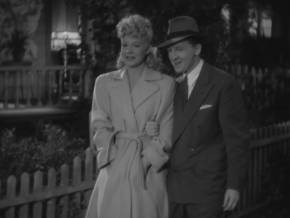 |
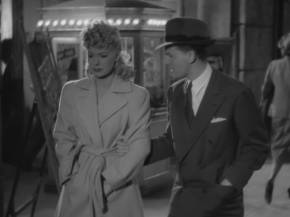 |
|
Figure 17a |
Figure 17b |
Walking to the movies, The Miracle of Morgan’s Creek
An Intimate and Well-Connected Community (Compact Socially)
Many of the points already discussed have noted the importance of social interconnectedness and familiarity to the depiction of the small town, with retailers knowing their customers intimately, and so on. This one-on-one connectedness emphasises the small scale of the communities in question (the population of Our Town’s Grover’s Corners, for example, is explicitly stated to be 2642). In addition to the aspects of interpersonal familiarity already discussed, two other points are worth making that underline the sense of the town’s population comprising as an identifiable, unified community (rather than people being part of a larger undifferentiated mass of residents, as might occur in a suburb). The first notable point is the downside to social interconnectedness, with the power of gossip being a recurring theme. In Our Town, it is implied that the organist has taken his life at least partly because of the gossip of the congregation. In The Magnificent Ambersons the townsfolk are seen gossiping about George Minafer and hoping for his downfall. In Kings Row both Dr Tower and Dr Morgan are motivated at various points by the desire to hide the hysteria of their daughters. Good-time girl Violet feels the need to leave town in It’s a Wonderful Life after, it is hinted, one personal scandal too many. Similarly, the plot of The Miracle of Morgan’s Creek is propelled by Trudy Kockenlocker’s fear of public shaming after she becomes pregnant but can’t remember who she married. All these points show the negative side of small town life, but they still underline the sense of community: the gossip would not exist, or at least not have the same power, in the anonymity of the suburbs. A more positive aspect of the sense of community interconnectedness is the emphasis on communal celebration: events that bring much of the community together to mark events together. Such occasions include the dance at the school in It’s a Wonderful Life, Harry Bailey’s homecoming ceremony in the same film, and the dances for the troops in The Miracle of Morgan’s Creek. In addition to this, there are the large domestic parties we see in Meet Me in St. Louis and The Magnificent Ambersons: the latter, in particular, is noted as “the last of the great long-remembered dances that everybody talked about,” suggesting the departure of the days in which an event held by a single family can be remembered as an important occasion for a whole community.
A Close Link between Town and Country
The idea of compactness, both physical and social, reinforces the sense of the town’s clearly defined geographic identity. Unlike suburbs, which tend to bleed into each other with a continuous built form, small towns such as those depicted in these films can be distinguished by a change at their boundaries to non-urban forms. In practice, in the American small town movie, that non-urban form is a rural setting. A close link to rural landscapes emphasises the desirable proximity to the countryside that cities and suburbs lack (harking back to the ideal of a balance of community and accessed to nature embodied by conceptions such as Howard’s “Three Magnets”); while a link to rural lifestyles evokes a nostalgic sense of simpler times and old-fashioned values. Our Town underlines Grover’s Corners’ rural situation through its framing device: Morgan narrates the film from a hilltop overlooking the town, giving a clear visual sense of its location in the countryside. In keeping with the film’s economical but very communicative use of sets, the hilltop sports a dilapidated boundary fence and a smattering of trees, evoking both farmland and a genteel form of wilderness. Morgan further underlines the town’s closeness to farmland by contrasting the townsfolk’s sleeping habits with those of the rural workers in its hinterland:
The only lights on in the town are in a cottage over on Polish town where a mother’s just giving birth to twins, and down in the depot where Shorty Hawkins is just getting ready to flag the 5:45 to Boston… Of course, naturally out in the country all around there have been lights on for some time, what with milking and so on, but townsfolk sleep late.
While a contrast is drawn between the farmers and the townsfolk here, the proximity between the two is nevertheless underlined, and dawn is still marked by a rooster crowing. In Kings Row, the rural context is instead emphasised through scenes that highlight the availability of rural landscapes for healthy recreation: Drake McHugh’s vitality prior to losing his legs is communicated largely by his fondness for buggy rides into the country, and a number of scenes take place in the idyllic countryside around the town. The film particularly emphasises the countryside as a location for romance. In the opening scenes the young Parris Mitchell and Cassandra Tower play together along a stream, and as adults both Drake and Parris have romantic encounters in the countryside around the town (Drake with the Ross twins and later Randy Monaghan, and Parris with Cassandra and Elise Sandor). A similar trip through the countryside is shown in The Magnificent Ambersons, when George Minafer’s buggy encounters Eugene’s car in the snow-covered landscape just out of town. Again the sequence emphasises both wholesome outdoor activities (the occupants of the two vehicles laugh and frolic in the snow) and romance (George steals an awkward kiss from Lucy after they fall off their buggy). There is, however, something of a bitter edge to the sequence, and the pressures on the rural landscape are hinted at by the spluttering smoke from Eugene’s car (the spoiling of the landscape by cars is a recurring theme to which I shall return).
It’s a Wonderful Life echoes the themes evident in these earlier films. It, too, shows the landscape around town as a site for youthful adventure, with the first scene in Bedford Falls showing George and Harry Bailey, as children, tobogganing with their friends in the woods. Even in this early sequence, however, there is a subtle foreshadowing of the potential loss of the rural land: a sign behind George Bailey reads “No Trespassing – Henry F. Potter,” implying that this is the land that will become the Potter’s Field housing estate. This almost subliminal hint that the land development on which the plot turns is eating up the rural land around town is made more explicit later in the film, when Potter’s rent collector describes how the site of George Bailey’s housing development had been fifteen years earlier: “squirrels, buttercups, daisies – I used to hunt rabbits there myself.” Even as he helps contribute to the town’s growth, however, George Bailey clings to the ideal of the town as a rural haven, and shares the predilection of Drake McHugh in Kings Row for using the countryside as a site for seduction. After telling his mother (of all people) that he is off to “find a girl and do a little passionate necking” he meets the sexually aggressive Violet in the centre of town and suggests they “make a night of it.” His idea of the night is steeped in appreciation of the enjoyment of the natural environment:
Let’s go out in the fields and take off our shoes and walk through the grass… Then we can go up to the falls; it’s beautiful up there in the moonlight. And there’s a green pool up there, and we can, ah – swim in it. And then we can climb Mount Bedford, and smell the pines, and watch the sun rise against the peaks, and we’ll stay up there the whole night, and everybody’ll be talking, and there’ll be a terrific scandal!
Violet, although initially keen, is at first puzzled and then aghast at George’s suggested activities: “Why, it’s ten miles up to Mount Bedford!” Robert Beuka has argued that this scene shows that George is “clinging to his nostalgic vision of a primarily rural Bedford Falls” and is largely oblivious to the changes that have come across the town since his childhood.39 I will return to this idea of the town being under pressure from development, but more important here is George’s attitude to the countryside, rather than whether or not that landscape has already been spoiled. Violet’s concern is not so much how far away the grass is: she is appalled at the very concept, which underlines her romantic unsuitability for the more whimsical George. Yet George, always the human embodiment of everything that is best about Bedford Falls, understands the importance of the town’s rural hinterland to the community. Despite the film’s wider difficulty reconciling the competing aims of affordable housing and preservation of the environment, George’s speech underlines the importance of a pastoral setting to the idealised small town.
Family Units as the Essential Building Blocks of the Community
The scene between George and Violet immediately precedes his visit to the more responsible Mary Hatch; his marriage to Mary is the primary narrative expression of George’s embrace of a domestic life and responsibility. This key turning point underlines the primacy of family groupings in structuring society in these small town films. This is of interest because of the particular importance of family housing in post-World War II suburbia developments. While families have long held a central role in the structuring of societies, the ad-hoc construction of traditional cities and towns ensured a variety of housing types, including smaller apartments to cater for different household sizes. Mass-produced suburbs, however, entrench the family as the key social structure in their very fabric through the embrace of multi-bedroom detached houses on large grounds as their basic unit of construction: suburbia is made up of little other than family housing. The resulting monoculture is one of the key criticisms of the suburban model of urban development, and is criticised for isolating the very families whose needs it is supposed to serve. As Lewis Mumford puts it:
Instead of centering attention on the child in the garden, we now have the image of “Families in Space.” For the wider the scattering of the population, the greater the isolation of the individual household, and the more effort it takes to do privately, even with the aid of many machines and automatic devices, what used to be done in company often with conversation, song, and the enjoyment of the physical presence of others.
The perils of such social isolation are often underestimated in traditional suburban development because the social life is expected to occur primarily at home, in the family unit. Suburbs represent a structuring of the city based on the assumption that family is community.
This family-centric outlook is reflected in the films studied. Families are the window through which we view these communities, with the films centering on family groups: The Webbs and Gibbs in Our Town; the Ambersons / Minafers in The Magnificent Ambersons; the Newtons in Shadow of a Doubt; the Smiths in Meet Me in St. Louis; the Kockenlockers in The Miracle of Morgan’s Creek; and the Baileys in It’s a Wonderful Life. Only Kings Row, where the crucial relationship for the parentless Parris Mitchell is with the surrogate father figure of Dr Tower, bucks the trend somewhat (although an important subplot relates to the dysfunctional relationship between Dr Tower and his daughter). These family groups are the window through which we see the towns depicted, and as such, the fates of the families and towns are closely intertwined. In The Magnificent Ambersons, for example, the decline of the Amberson / Minafer family parallels the declining fortunes of the town, the wider shift to an industrial economy, and the resultant passing of a way of life. In Shadow of a Doubt the small town family is susceptible to the malign influence when Uncle Charlie arrives from Philadelphia; the family dynamics play out a wider collision of their small town values with his corrupting urban influence. The role of families in reconstructing the town by replicating the family structure from generation to generation is also foreground through an emphasis on inter-generational relationships and child-rearing. In most of the films we see three generations of the central family, and explore the lessons passed from one to the other (most directly in the paternal lectures delivered to George Bailey and George Gibbs by their fathers in It’s a Wonderful Life and Our Town). Children are much more prominent than in most Hollywood films, with significant time spent chronicling their activity and play in Our Town, Shadow of a Doubt, Meet Me in St. Louis, and It’s a Wonderful Life. In two of the films (Kings Row and It’s a Wonderful Life) we follow characters from childhood to marriage, and in Our Town we have a similar flash-forward from late adolescence to marriage and children. The Miracle of Morgan’s Creek derives comedy from taking this reproductive obsession to its extreme, with the titular miracle being the birth of sextuplets. This emphasis not just on romantic coupling – which is ubiquitous in all Hollywood genres – but also on growth, intergenerational relationships, and having children, underlines the role of the family in constructing and reconstructing society.
By placing families in such a central role, small-town films are closely associated with the genre of family melodrama, although in fact only two of the films studied here – Kings Row and The Magnificent Ambersons – comfortably fit the description.40 However, the link to melodrama, a genre frequently analysed in terms emphasising its subversive depiction of families as repressive and dysfunctional, raises the issue of whether there is a darker undertone to the foregrounding of family. Thomas Schatz has argued that in the 1940s “even apparently optimistic films… rely for their impact on the gradual erosion of our cultural confidence in the nuclear family,”41 and Eugene Levy makes a similar point about small-town films across time periods:
The inadequacy and malfunctioning of the nuclear family (single or two-parent) has been a dominant motif in small-town films: the family is often a malignant structure… The attitude to the family is at best ambivalent: it can be supportive but, more often than not, is repressive.42
Levy finds this idea of familial repression to be more strongly found in the small town films of other decades, notably the 1950s, and indeed the warmth of many of the family scenes in the studied films would not support a generalised conclusion that family life is seen as repressive. However, it is interesting to note that the two films that make the structure and functioning of the town most central to their narrative (Our Town and It’s a Wonderful Life) both foreground the ambivalence of their protagonists about marriage and family.
In Our Town, the idea that there is something almost suspect about not marrying and starting a family is stated unusually baldly as Morgan introduces the film’s second section, which he titles “Love and Marriage.” Summarising the events of the three years since the introductory sequence, he notes:
Nature’s been pushing and contriving in other ways, too. A number of young people fell in love and got married. Most everybody in the world gets married; in this town there aren’t hardly any exceptions. Most everybody climbs into the grave – married.
In Our Town the courtship of George and Emily is a compressed version of time-honoured structures for romantic narrative: he seems stand-offish, but they resolve their differences and resolve to spend their life together. Yet instead of placing the wedding at the conclusion of the film, Our Town makes it a central scene about two-thirds through the film, throughout which the film focuses on the attitudes of the various participants by giving us their thoughts in voice-over. These offer a far from conventionally romantic view of the ceremony, starting with the jaded attitude of the minister:
I’ve married two hundred couples in my day. “M” marries “N” – millions of them. The cottage, the go-cart, the Sunday-afternoon drives in the country, the first rheumatism, the grandchildren, the second rheumatism, the deathbed, the reading of the will. Once in a thousand times it’s interesting.
The couple themselves are even less enthusiastic. As Emily stands in front of the church, her internal monologue is one of loneliness and resistance:
I’ve never felt so alone in my whole life. I don’t want to get married! Why can’t I just stay for a while as I am?
Meanwhile, George is pacing nervously, with similar misgivings:
Gee, I’m going to get married. I’m grown up. I’m getting old. I don’t want to get old. Taking on all these responsibilities. Why’s everybody pushing me so? All I want to do is be a fellow. And I’m gonna get married.
Yet when his teary mother enters, he suppresses his thoughts, telling her: “Cheer up mom, I’m getting married!” The film ends on an ultimately upbeat note; in a departure from the source play, Emily survives after nearly dying from complications related to the birth of her second child. Her will to live is affirmed after she is magically able to observe her earlier family life; seeing her parents and her younger self she learns to appreciate the bonds that underlie everyday domestic events. Yet the idea that unspoken fears and regret hang over the institution of marriage significantly qualifies Our Town’s otherwise affectionate depiction of family life.
This depiction is closely echoed in It’s a Wonderful Life, which amongst its other themes is an extended reflection on George Bailey’s reluctance to settle for a conventionally domestic existence. As an adolescent, George boasts of being nominated as a member of the National Geographic Society and talks of far-off lands, and is largely oblivious to the infatuated Mary. Yet George’s life of adventure is constantly thwarted by family obligations. At first these are those of his immediate family: first he is pressed into working for the family business after his father’s stroke, and then the marriage of his brother Harry prevents him offloading those responsibilities. In the later parts of the film, Mary and his children become the source of his frustration. This is most clearly articulated in the scene where the pair finally starts their romantic relationship after previous false starts. As already discussed, George has been urged to visit Mary by his mother, but only does so after Violet – the film’s embodiment of commitment-free sex appeal – rejects him. Mary is transparently desperate to recommence their interrupted romance, but George is at first surly and rude to her, cruelly rebuffing her advances. Yet his attraction to her overwhelms his doubts as they both talk on the phone to potential romantic rival Sam Wainwright, who offers to get him in on the “ground floor” of the plastics industry.43 Overcome by his attraction to her, he drops the phone and seizes her roughly, telling her:
Now you listen to me! I don’t want any plastics, and I don’t want any ground floors, and I don’t want to get married ever, to anyone! You understand that? I want to do what I want to do… and you’re… and you’re…
Unable to continue, he breaks down, hugs and kisses her – and we cut to their wedding. George’s barely repressed resentment of Mary is further underlined as they honeymoon in Bedford Falls, in a run down house Mary has purchased for them and decorated with pictures of the island paradises he had earlier talked of visiting. By the time he hits rock bottom after the loss of $8000 from the Bailey Building and Loan, George’s bitterness has extended to his children as well. In a nightmarish sequence that anticipates the more literal nightmare of the Pottersville sequence, George paces through his house on Christmas Eve, pestered by his children and voicing his dissatisfaction with his life, starting with an expression of disgust when told their families will be visiting: “Families? I don’t want the families over here!” As Mary tells him of their daughter’s cold he continues, bitterly venting his frustration at the life that Mary has dragged him into:
It’s this old house – I don’t know why we don’t all have pneumonia. Drafty old barn! It’s like living in a refrigerator. Why did we have to live here in the first place, and stay around this measly, crummy old town? … You call this a happy family? Why did we have to have all these kids?
As in Our Town, it is a magical intervention that turns George around. After visiting the alternate world of Pottersville – which is populated by singles and broken families, with Mary now an “old maid” and cab driver Ernie having been deserted by his wife – George finally comes to appreciate the value of his domestic bonds. Yet as in the earlier film the bitterness cannot be entirely expunged. As Robin Wood puts it:
It’s a Wonderful Life manages a convincing and moving affirmation of the values (and value) of bourgeois family life. Yet what is revealed, when disaster releases George’s suppressed intentions, is the intensity of his resentment of the family and desire to destroy it…44
Both films give voice to anxiety about family life, and particularly the sacrifices it requires people to make. Yet this doubt actually only underlines the film’s insistence on family as the building block of community: the entrapment of these characters occurs largely because the social pressure on them to start a family is so overwhelming. This sense of family existence as either inevitability or even something close to a civic responsibility foreshadows the social organisation of suburbia. The lesson learnt by George Bailey in It’s a Wonderful Life – that domestic bonds are ultimately all that is needed to make life rich and rewarding – can be seen as an expression of the principles that would underpin postwar suburban development.
A Population that has a Multi-Generational Link with the Community
The emphasis on family as the structuring element of society, and on inter-generational reproduction of that social structure, raises the closely related idea of the town’s continuity over time. We have seen a suggestion of this in the town’s physical form, with the emphasis on classical forms of architecture: these imply a reassuring permanence and a link with history. However, we also see a similar historical grounding in the town’s social structures. The social equivalent of the long-standing civic building is the long-established family that is widely known to the townsfolk: the Ambersons in The Magnificent Ambersons are the definitive example of such a respectable “old money” family in the films discussed. Yet such links are not confined to the aristocracy. In Our Town Morgan notes that many local families have a history with the town that extends back to the seventeenth century:
The earliest dates on the tombstones up there in the cemetery say 1670. They’re Grovers, and Cartwrights, and Gibbses, and Percy’s. Same names as you’ll find here now.
This point is reinforced in the film’s final part as Morgan takes a walking tour of the cemetery, commenting upon the lives of those buried there. This kind of link with history is echoed in It’s a Wonderful Life when George Bailey, drunk, drives his car into a tree. A resident emerges from a nearby house and scolds him: “My great grandfather planted this tree!” Interestingly – and in defiance of the story’s internal logic – when George Bailey is in the nightmare version of the town, that history has been erased. The same man walks past and George asks him where his car has gone, referring to himself as “the fellow that owns the car that ran into your tree.” Yet now the man makes no reference to his personal tie to the tree, simply asking: “What tree?” Here the specific logic that the Pottersville sequence hinges on George’s non-existence is overwhelmed by the underlying sense that in Pottersville everything good about Bedford Falls is subverted: that includes the population’s link to its history, even if there seems no way that George could have effected the actions of the man’s great grandfather. What the town loses when its history is erased is a key differentiation from suburbs. Suburbs are a form of town with no history: recently constructed, populated by new arrivals with no shared background, and thrown together by a property developer. The emphasis on the history of small towns, by contrast, makes the community seem somehow more genuine and permanent than their ersatz suburban equivalents.
De-Emphasis of Cars and Emphasis on Various Forms of Non-car Transport
Cars are present in most of the films studied, and in some cases (notably The Miracle of Morgan’s Creek and Shadow of a Doubt) we see streets that are bustling with cars. However, cars are de-emphasised both in their visible presence, and in their influence on the physical environment. This occurs in a number of ways. Firstly, cars are generally seen in motion, with relatively few parked cars visible on streets, particularly in residential areas. There are no signs of a physical environment that has been redesigned for cars: we see no parking lots, for example, and the Main Streets we see are still pre-car era streets that happen to now be used by cars (rather than, for example, highways with roadside retailing). In residential areas, garages are not a prominent element in the streetscape architecture: even in Shadow of a Doubt, where the presence of a garage on the family house is a plot point, it is tucked away beside the house and is not prominent in establishing shots (figures 10c and 11e). As already noted, Main Street remains a pedestrian-dominated space and the fabric of the town remains sufficiently physically compact that many trips can be completed on foot.
The role of cars is also downplayed through the prominence given to non-car forms of transport. This is, for obvious reasons, most notable in the period films mentioned, in which horses and carts are prominent on the street. However, Preston Sturges also frequently shows horse-drawn vehicles in The Miracle of Morgan’s Creek, suggesting the old-fashioned nature of that community, even as it is buffeted by the social change embodied by the visiting troops; cars, meanwhile, are associated with sexual promiscuity as Trudy Kockenlocker drives from party to party during the binge in which she falls pregnant. In Kings Row Drake McHugh is frequently seen on his buggy, and some dialogue scenes take place as characters travel on it; Orson Welles stages scenes in The Magnificent Ambersons in the same manner, most notably as Lucy rebuffs George Minafer’s discussion of marriage. In Meet Me in St. Louis and The Magnificent Ambersons we see streetcars employed. In the former film they signify excitement and romance, while in Ambersons they typify a slower and more dignified time, as explained by the narrator:
The only public conveyance was the streetcar. A lady could whistle to it from an upstairs window, and the car would halt at once, and wait for her, while she shut the window, put on her hat and coat, went downstairs, found an umbrella, told the girl what to have for dinner, and came forth from the house. Too slow for us nowadays, because the faster we’re carried, the less time we have to spare.
The other particularly prominent non-car transport is the railroad. In Our Town, the start of the day is marked by the arrival of the train, and the train station is a recurring feature in these films, marking important arrivals and departures: Uncle Charlie in Shadow of a Doubt; Parris Mitchell in Kings Row, George and Isabel Minafer in The Magnificent Ambersons; and Harry Bailey in It’s a Wonderful Life. As the chief form of intercity transport, and the jumping off point for international travel, railroads suggest adventure (or, for George Bailey, foregone adventure). The trips taken by characters by train would almost certainly be undertaken by car or plane today, but trains provide a stronger focal point for to mark such comings-and-goings: unlike cars, they provide a central building from which trips commence; while unlike airports, the railroad station can be located within small towns and close to the centre of town, and thus become a true civic building physically embedded in the fabric of the community.
The passage of time, of course, has made the train a more exotic form of transport than it was at the time these films were made; much of the romance of the railroad perceived by the present-day viewer may be applied retrospectively. However, there is still basis for assuming that the railroad was considered in a somewhat nostalgic light even at the time of production when one considers the strong antipathy shown towards cars in the films. The association of cars with the decline of small towns is striking. In Our Town, after George concocts a story about Emily nearly being struck by a horse and cart, Morgan observes how the arrival of cars threatens to change to town:
Now with all these automobiles coming along, it looks to me like the only safe place to stay is the home. Gracious, I can remember the time when a dog could lie in the middle of Main Street all day long without anything coming along to disturb him.
I have already mentioned the way the car fouls the rural environment in The Magnificent Ambersons, and throughout that film automobiles are used to amplify the interpersonal conflict between the aristocratic George Minafer and the inventive industrialist Eugene Morgan. The exchange between Eugene, George, Uncle Jack, and Major Amberson about automobiles is particularly prophetic in its discussion of the impact of the car on the town. Discussing the opening of a new horseless-carriage shop “out in the suburbs”, Major Amberson suggests: “perhaps the two of you will get together and drive all the rest of us off of the streets.” Eugene, with characteristic geniality, responds that “we’ll even things up by making the streets bigger,” anticipating the changes that traffic engineering would visit upon the urban fabric. They discuss the implications of running streets out to the county line (Jack fears this will cause a slump in property values in the old town), and Major Amberson asks if Eugene really thinks cars will “change the face of the land.” Eugene responds that this is already happening and can’t be stopped, prompting an outburst from George that “automobiles are a useless nuisance.” This prompts Eugene’s expression of doubt about the genie that he has helped unleash:
I’m not sure George is wrong about automobiles. With all their speed forward, they may be a step backward in civilisation. It may be that they won’t add to the beauty of the world or the life of men’s souls. I’m not sure. But automobiles have come. And almost all outward things are going to be different because of what they bring. They’re going to alter war and they’re going to alter peace. And I think men’s minds are going to be changed in subtle ways because of automobiles. It may be that George is right. It may be that in ten or twenty years from now, if we can see the inward change in men by that time, I shouldn’t be able to defend the gasoline engine but would have to agree with George: that automobiles had no business to be invented.
The automobile thus becomes a key sign of the decline of the town: while we are encouraged to sympathise with Eugene, rather than the spoilt George, the film’s tone is elegiac and suggests that the rise of the industrial age – and the car in particular – is extinguishing a particular way of life. Late in the film, the narration spells out the fate of the town: “it was spreading incredibly, and as it heaved and spread, it befouled itself and darkened its sky.” The speed, mobility and pollution of cars are here painted as fatal to the small town way of life.
A Period Setting, or a Sense of the Place Being “Out of Time.”
The anxiety expressed about the coming of the car, and the sense of anxiety about the golden age of small towns passing or having passed, helps explain the setting of so many of the films in the past: the romanticising of the town is nostalgic in tone, with the town associated with values of an earlier time. Even the films explicitly set contemporary with production show towns that hark back to earlier times: in The Miracle of Morgan’s Creek horses remain commonplace, and It’s a Wonderful Life includes flashbacks that show the centre of town to have changed little between 1919 and 1945. The use of an approximately turn-of-the-century time period is particularly common in these 1940s examples. Our Town commences in 1901, and concludes in 1913; Kings Row takes place between 1890 and 1905, and the start of the new century is specifically marked in a sequence set in 1900; The Magnificent Ambersons takes place between 1873 and 1904; and Meet Me in St. Louis takes place in 1903 and 1904. A number of complementary reasons can be suggested for this. In discussing the appeal of Disneyland’s Main Street USA, Francaviglia has argued that the very loose time period between the end of the American Civil War and World War I is the subject of a “deep collective longing for pre-urban Anglo America that was and indeed still is widely embraced by Americans of all backgrounds.”45 With World War I having been closely followed by the Great Depression and then the onset of World War II, the attractiveness of the period of perceived calm between the Civil War and these events is not difficult to understand. As alluded to in the preceding discussion of The Magnificent Ambersons, this was also a period of increasing industrialisation and urbanisation, with much of the population moving from small towns, and the towns themselves being transformed by the presence of industry (or swallowed up by the cities as railroads and then cars increased the ability to commute). As has been noted, the car becomes both a symbol of the wider industrialisation, and also a chief agent of change in its own right. The turn-of-the-century setting therefore strategically allows the films to address industrialisation and the arrival of the automobile. Finally, there may simply be a tendency to always locate the site of idealisation a few decades before the time in which cultural works are produced; this is a time in living memory, in the youth of many of the film’s contemporary audience, and the association of nostalgic yearning with such recent past is easily understandable.
This latter point is supported by the fact that in more recent films such as Back to the Future (Robert Zemeckis, 1985), Pleasantville (Gary Ross, 1999), and Blast from the Past (Hugh Wilson, 1999), the 1950s or early 1960s become the time period associated with many of the idealised traits identified in this article. In those films, however, the location embodying the ideals has switched from the small town to early suburbia, suggesting some of the continuity between the ideal of the small town and that of the idealised suburb. Of course, such films often mingle genuine nostalgia with a mocking, ironic awareness: they contrast the (perceived) naivety of the 1950s, and the expectations of communities at that time, with the realities of modern suburban lifestyles and values. However, I would suggest that we tend to overestimate the credulity of previous generations. This leads into the next point for consideration: the attitude to suburbanisation in the films discussed.
Portents of Doom: The City and Suburb in the 1940s Small Town Movie
Thus far, I have concentrated on those aspects of the small town life that typify the idealised form of such communities, and have referred only in passing to the elements of the films that suggest threats to that existence. The small town is, I suggest, generally painted as an alluring and attractive place; even in a film such as Kings Row that spends a great deal of time on the community’s hidden scandals, the town itself seems very attractive. However, there are also suggestions in the films studied of the perils facing the small town. These are expressed both through anxiety about the town’s vulnerability to corruption from malign urban influences, and also in the consideration of the ability of the small town to survive the coming age of suburbanisation.
I have already noted that Shadow of a Doubt is of some interest for showing the small town on the cusp of suburbanisation, with its relatively urbanised Main Street. Hitchcock, still new to America, clearly wished to use the film to explore the United States’ self image, rather than simply its potential as a family melodrama: revealingly, he brought in Thornton Wilder, who wrote Our Town, and Sally Benson, author of the original stories that inspired Meet Me in St. Louis, to help provide an appropriate sense of small-town flavour and to strengthen the depiction of the family.46 In this context, it is interesting to note the film’s association of Uncle Charlie with the moral and physical corruption of the city. The film’s opening sequences associate Uncle Charlie with a particularly bleak, run-down vision of Philadelphia (figure 18). The city is defined visually by industrial waterfront, huge bridges, abandoned vehicles, empty lots, abandoned buildings, rubbish in the streets, and a lack of pedestrian activity. As Colin McArthur notes, the scenes foreshadow images of the inner city as an urban wasteland that would become prominent in American films of the 1980s and 1990s;47 when contrasted with the Santa Rosa scenes, the film becomes a veritable advertisement for the abandonment of the inner city. More interesting, though, is the way Santa Rosa itself becomes more urban and threatening as Charlie becomes suspicious of her uncle. The town centre is increasingly seen at night, and assumes noir-ish overtones. The first hint of this is in the night-time scene when Detective Graham tells Charlie that her uncle may be a wanted man. Later, as Charlie’s hysteria grows, she half-runs through the streets and Hitchcock’s compositions become more cluttered and busy: we see Charlie through store windows, surrounded by people and with the background filled with signage and cars (figure 19a). Moments later, her distress is marked by her being nearly run over by a car. Later, when Uncle Charlie pursues her to confront her about her suspicions, the imagery becomes even more urban and threatening: the pair enter a seedy-looking late night bar (“’Til Two”), marked by neon signs advertising cocktails (figure 19b). The younger Charlie protests that she’s “never been in a place like this:” the bar is dark and smoke-filled, and packed with disreputable characters and sullen waitresses. It is as if Uncle Charlie’s corruption, and his view of the world as a “foul sty,” has reshaped Santa Rosa into a previously suppressed noir urban form.48
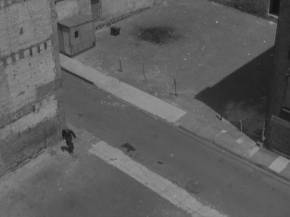 |
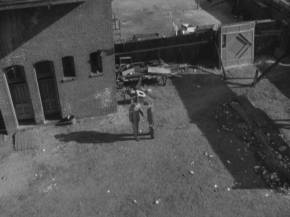 |
|
Figure 18a |
Figure 18b |
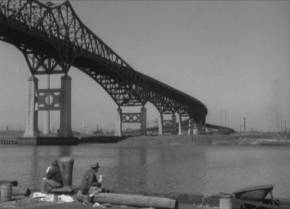 |
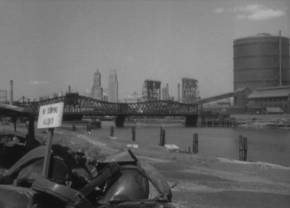 |
|
Figure 18c |
Figure 18d |
|
Decaying City, Shadow of a Doubt |
|
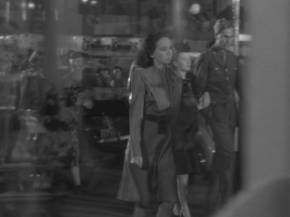 |
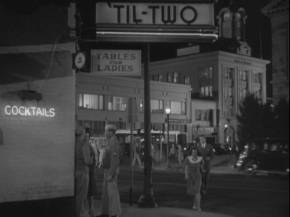 |
|
Figure 19a |
Figure 19b |
Noir Santa Rosa, Shadow of a Doubt
A similar moment of association between vice and urbanity occurs early in It’s a Wonderful Life, when George, Bert, and Ernie ogle the attractive Violet. Violet is established as sexually aggresive, in contrast to the domestically inclined Mary. Capra echoes Hitchcock’s approach by emphasising her looser morals through more urbanised imagery: as she leaves, we get a shot of her on the street that is the most urbanised view we get of the “real” Bedford Falls (figure 20). Capra uses a long lens, and positions the camera facing down the street, so that layers of signage, telegraph poles and street furniture are cluttered together, in contrast to the more sedate compositions we see of the street elsewhere.49 The shot is framed with a car on the right, and another enters on the left mid-shot: again the device of someone nearly being run over is used as punctuation, although here for more comic effect. Violet has a similar influence later in the film, in the sequence already discussed in which George meets her in the street and tries to lure her into the countryside. In this sequence we once again see a more urbanised Bedford Falls: as Robert Beuka puts it, the town here seems to have become “a rather sophisticated, even racy town.”50 Again there is a sense that the town’s visual landscape responds to the morals and interests of the characters who inhabit it.
Figure 20 – Good time girl as force for urbanisation, It’s a Wonderful Life
A much more dramatic explosion of urbanity, however, is the “Pottersville” sequence, in which guardian angel Clarence creates a world in which George Bailey hasn’t been born. The nightmare of the sequence is conveyed not only by what has happened to the people of the town – depravity, prison, and spinsterhood – but also through the physical changes to the town. As both Frank Krutnik and Robin Wood have argued, Pottersville sees the intrusion of a noir city into what has previously been an idealised Middle-American community (figure 20).51 Instead of the benign retailing previously seen along the street, the street is filled with uses associated with vice: bars, dance halls, burlesque / strip joints, pawnbrokers, and boxing establishments. Signage has switched from traditional painted signs to a proliferation of neon and other illuminated signs: even the discreet “You Are Now in Bedford Falls” sign (figure 4d) has been replaced by a strident neon “POTTERSVILLE” sign (figure 21d). As Michael Willian points out, even the road signs take a hectoring tone, suggestive of the way in which the pedestrian’s freedom of movement exhibited in Bedford Falls has been curtailed: signs read No Parking, Keep Moving, No Left Turn, No Dogs Allowed, No Loitering, and Keep Off the Grass.52 Importantly, what distresses George the most is his anonymity. While this is motivated in the film by the fantasy premise of his never being born, it underlines the way in which the intimacy of the small town has been snuffed out and replaced by the anonymity of the city. As Krutnik puts it, a structure of society bound by social norms and shared experience has been replaced by a community characterised by impersonality and self-interest:
The folk community of Bedford Falls resembles Thomas Jefferson’s pastoral ideal, a realm of localized Americanism protected from the pestilence of urbanity. And Pottersville is a corrupted city of strangers that has betrayed the Edenic promise of America – a world in which consensual social bonds have been obliterated under the pressures of unchecked capitalism.53
Those two extremes are, in this instance, represented visually by the binary opposition of “small town” versus “urban;” Clarence’s magical intervention has swung the town from one side of that opposition to the other. As is often noted, however, one of the slightly unnerving things about the film is the narrowness with which it avoids the all-pervasive gloom that it contemplates as George loses his faith and descends into Pottersville.54 As Robert B. Ray puts it, the film “implicitly [discredits] every common man but George, without whom average citizens become drunkards, poisoners, old maids, prostitutes, bullies, madmen, and embittered old women.”55 In the current context what is interesting is how little needs to change for the city to overrun all the virtues of the small town. The small-town character of Bedford Falls is literally shown to hinge on one man; without George Bailey the rapacious developer (Potter) would overrun the town.
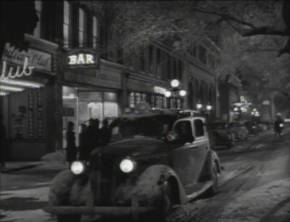 |
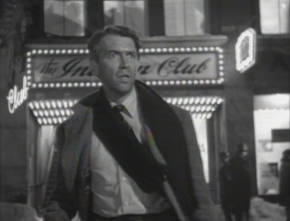 |
|
Figure 21a |
Figure 21b |
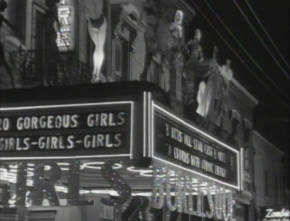 |
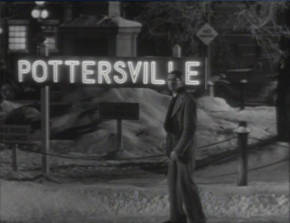 |
|
Figure 21c |
Figure 21d |
|
Pottersville, It’s a Wonderful Life |
|
In these examples the tension is between the loss of small town charm in the face of urbanising forces: the city represents anonymity, sin, and unbridled capitalism. However, there is also some reflection in the film of the tension underlying the conversion of small towns to suburban living, as ways are found to accommodate all those who need housing. In its preoccupation with this theme It’s a Wonderful Life echoes and expands upon Kings Row. In that film, Drake McHugh and his girlfriend Randy Monaghan take a sojourn in the country: Drake, it is clear, has sex on his mind but Randy takes him to an idyllic piece of countryside (figure 22a) and suggests he buys it. “This junk?” he says incredulously, but Randy persists: “It can be cleared and drained. After all, there are lots of people who work in the claypits and the mills and the coal mines who would like to own homes too.” Later, after Drake loses his legs in an accident, he supports himself by realising Randy’s idea: we even see the plans of his subdivision (figure 22b), the first tract of which has been sold. It is a classic residential grid, with no sign of anything other than housing lots and the creek that bisects the land.56 “The claypit workers took most of them,” says Drake with pride. “Low prices but they make wages and pay off.” The role as a community builder gives the otherwise shattered Drake a sense of purpose. There is no intimation in Kings Row of the loss of the countryside that might go with the exercise of building cheap and plentiful homes for all, and at the film’s conclusion Drake’s recovery is signalled by his desire to take one of the lots and move out of the cheap downtown accommodation he shares with the Monaghans, and to take an allotment in his subdivision.
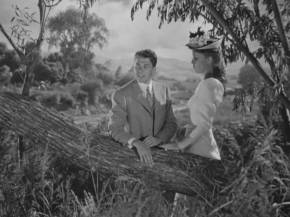 |
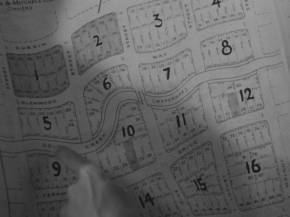 |
|
Figure 22a |
Figure 22b |
Subdividing the countryside, Kings Row
It’s a Wonderful Life also shows us how George Bailey’s life is given meaning by his community building, but delves into the subject in some more detail. As such, it exposes more of the conflict inherent the process of suburbanisation. George’s role as community builder is crucial to the lesson he learns in the film, as he comes to appreciate the town he repeatedly disparages early in the film (referring to it as a “crummy old town” and expressing disbelief that someone could miss Bedford Falls). His thwarted ambitions as an architect / urban planner are redirected into the Bailey Building and Loan, which is gradually revealed to be crucial to resisting Potter’s urbanisation. The film neatly sums up the genuine concerns with pre-suburban and inner-urban housing by using Potter to highlight the poor quality of residences prior to widespread suburban rollout. Potter is depicted as a slum landlord, keeping residents renting – “living like pigs,” as former resident Martini puts it – in his Potter’s Field estate. During the run on the Building and Loan, George tries to dissuade the townsfolk from busting him by reminding them of the poor quality of Potter’s housing. We briefly glimpse Potter’s Field as Martini moves out of it: the estate is shown to have an almost shanty-town appearance, with run-down buildings and unfeasible number of people milling around the frame (figure 23a). Martini has now achieved the dream of home ownership, and Potter’s business is dwindling: his rent collector enthuses about the quality of the Bailey Park Estate and its homes, telling Potter that “Potter’s Field… is becoming just that.” The struggle over the built form of Bedford Falls that occurs in the film’s fantasy sequences, and (as previously mentioned) at times in its visual structure, is made more literal in the struggle between George Bailey and Potter over how the town’s residents should be housed. George has realised his ambitions by making housing affordable for everybody in Bedford Falls, and this is key to the appreciation of the community that drives the redemptive final sequence. Capra thus suggests George is the agent of a more benign type of developer, one for whom personal profits are secondary and community building is paramount. At one level, therefore, the optimistic and populist Capra strongly endorses the suburban ideal of home ownership, suggesting the actions of George Bailey make housing affordable for everybody.
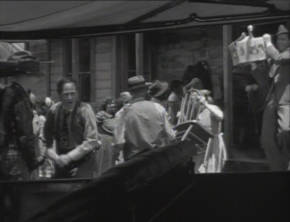 |
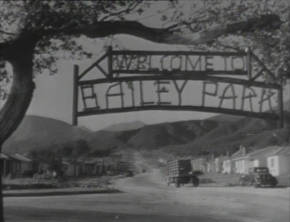 |
|
Figure 23a |
Figure 23b |
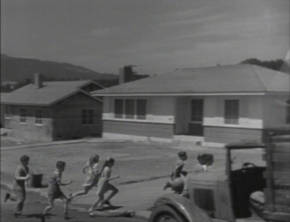 |
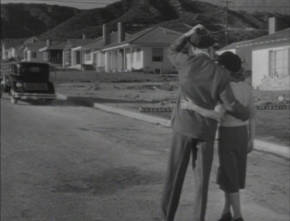 |
|
Figure 23c |
Figure 23d |
|
Potter’s Field and Bailey Park, It’s a Wonderful Life |
|
What is striking about the Bailey Park sequence, however, is how drastically Bailey Park differs from downtown Bedford Falls, and the ideals of community discussed in this article. As Robert Beuka notes, Bailey Park seems:
… a visual aberration, in that it depicts a landscape so markedly different from everything else we have seen in the film… the small, fairly uniform ranch houses of Bailey Park, with their distinctly postwar suburbia look, seem a step out of the film’s timeframe.57
The Bailey Park we see is filled with characterless bungalows and largely devoid of trees (figures 23b-23d); it completely lacks the charm evident throughout the sequences in the old town of Bedford Falls. Nezar AlSayyad notes this contradiction:
…in contrast to Bedford Falls, there is no street life in Bailey Park. There are no trees, only lawns; no porches, only private back patios. Moreover, it is constructed on what was once the cemetery, thereby erasing traces of lineage and history… George and Mary continue to live in the old part of town, making it new by rebuilding and repairing it.58
Both AlSayyad and Beuka suggest that this somewhat conflicted view of Bailey Park reflects “anxiety… over the sense of the small-town American landscape in transition,” (Beuka’s phrase) where Bedford Falls finds itself in limbo “between inside and outside, present and future, small town and big city, community and society, tradition and modernity” (AlSayyad’s description).59 Much of this underlying tension in the film as a whole is clearly deliberate, given the way Capra sets up Potter and George Bailey as competing forces fighting for the soul of the town. Yet I would argue that given Capra’s unequivocal association of George Bailey as a force for good (and for the protection of the town), and Potter as force for evil (and for the debasement of the town), it was not his intent that the sequence at Bailey Park be ambivalent. On the contrary, this is the moment where by associating suburbia with George Bailey, Capra is expressing confidence in the suburban future. George Bailey is shown not only to preserve the traditional character of Bedford Falls (by averting its urbanisation) but he is able to make it affordable for all.
The difficulty with the Bailey Park scene arises because of shortcomings with the iconography of the attractive community. Capra has established Bedford Falls as an attractive place to live by trading on the multi-faceted iconography of the small town that have been discussed. I have suggested that the appeal of the suburb is based on the notion that it can deliver the benefits of the small town, and I think it should be apparent that many of the traits outlined in this article inform the stereotype of the idealised suburb that we now tend to associate with the 1950s sitcom. In this sense, the idealised suburb and the idealised small town blur together. Kenneth Mackinnon notes this in his study of small town movies, suggesting that while he considers Meet Me in St. Louis a small-town film, it is a difficult film to categorise because “movies set in the suburbs of cities deliberately take on the look, and therefore share the charisma, of the small town movie.”60 I would suggest that of the films studied here, Meet Me in St. Louis is of particular interest as an early example of the idealised small town depiction transforming into the stereotyped / idealised suburb. In particular, its virtual absence of any sense of a town centre, and reliance on a purely residential conception of community, foreshadows suburbia’s separation of uses and focus on the domestic sphere as the main site of community togetherness. The problem Capra faces in the Bailey Park sequence is that this equation of “good suburbia” with the properties of a small town leaves him with no established system of signs for showing an estate that is not a small town (since we need to understand we are in Bailey Park, not old Bedford Falls) but which is nevertheless suburban and good. To visually signify that Bailey Park is suburban, rather than the old town, Capra has no choice but to make it visually less appealing. This gives us a hint of the semiotic problem suburbia faces. If there is a need to distinguish a space as specifically suburban, and not a small town, its suburban-ness will tend to be defined in the negative: through the absence of a Main Street, the absence of people on the street, and so on.
Conclusion
In this article I have outlined in some detail the qualities of the iconic filmed small town, as it existed at the dawn of the postwar suburban boom. I expect few of the traits I have outlined are surprising, as such: my point is more to highlight the sheer pervasiveness of those traits. This is of interest when we consider the extreme disconnect between the depictions of community in these films and typical lived experience in a modern suburb; the familiarity of the idealised small town tends to obscure its strangeness. Compare, for example, the experience of buying a suitcase from a typical suburban mall with that of George Bailey in It’s Wonderful Life. In real life this would be a humdrum excursion, most likely undertaken by car, and with little scope for community engagement or social interaction. George, by contrast, walks to a store that fronts a high street, rather than driving to inward facing mall tenancy; the shop owner knows his name; the luggage is paid for by another shop-owner with whom George has a longstanding friendship; he marches out of the store and is hailed from windows by his friends (figure 24); a beautiful woman makes a pass at him as he goes. It is at once irresistible and yet completely alien.
It is little wonder that our everyday experience of suburbia feels wanting by comparison with such a life. This generalised dissatisfaction with the suburban environment, and its relationship to our cultural depictions of community, raises important questions about how our expectations of our social and physical landscape are shaped. There is a complex interplay at work here. In one sense, it could be argued that the disparagement of suburbia is based on a confusion of fantasy and reality. When we compare our cities, and our lives, to those of characters in films, we will always come off second best, as their environment is always narratively purposeful. Characters know everybody they meet because it conveys story information and conveys information about character; their interactions are meaningful because they all serve the relentless drive of a classical narrative pattern; their physical environment is attractive because it is designed in support of an escapist genre entertainment. The randomness of real-life events, and the messiness of genuine environments, will not bear comparison with such a world. On the other hand, that fantasy is not without a real-world basis. In seeking to depict a pleasing idea of community, filmmakers draw on particular real world precedents, and draw on the much the same design principles as real-world architects, planners, and urban designers. These are design approaches that were frequently forsaken in suburban planning after World War II, and the problems of physical and social isolation in such suburbs are genuine. The nostalgia that is at work when we watch Our Town or It’s a Wonderful Life is not purely sentimental, or the product of misplaced confusion between fantasy and reality. It also reflects real shortcomings in our physical environment. Our filmed depictions of community are of interest not only as escape: they have become important shared reference points in the quest to find (and rediscover) better ways to build our urban environments.
Figure 24 – A typical walk down the street, It’s a Wonderful Life
Bibliography
AlSayyad, Nezar. Cinematic Urbanism: A History of the Modern from Reel to Real. New York & London: Routledge, 2006.
Althusser, Louis. “Ideology and Ideological State Apparatuses.” In Cultural Theory and Popular Culture: A Reader, edited by John Storey, 151-162. Cambridge: Harvester Wheatsheaf, 1994.
Beuka, Robert A. SuburbiaNation: Reading Suburban Landscape in Twentieth-Century American Fiction and Film. Palgrave Macmillan, 2004.
Bruegmann, Robert. Sprawl: A Compact History. Chicago and London: University of Chicago Press, 2005.
Fishman, Robert. Bourgeois Utopias: The Rise and Fall of Suburbia. New York: Basic Books, 1989.
Francaviglia, Richard. Main Street Revisited: Time, Space, and Image Building in Small-Town America. Iowa City: University Of Iowa Press, 1996.
—. “Main Street U.S.A.: A Comparison/Contrast of Streetscapes in Disneyland and Walt Disney World.” The Journal of Popular Culture 15, no. 1 (1981): 141-156.
Haberman, Donald. Our Town: An American Play. Boston: Twayne, 1989.
Hall, Peter. Cities of Tomorrow: An Intellectual History of Urban Planning and Design in the Twentieth Century. Third edition. Oxford: Blackwell, 2002.
Hayden, Dolores. Building Suburbia: Green Fields and Urban Growth, 1820-2000. New York: Pantheon Books, 2003.
—. “Building the American Way: Public Subsidy, Private Space.” In The Politics of Public Space, edited by Setha Low and Neil Smith, 35-48. New York: Routledge, 2006.
Howard, Ebenezer. Garden Cities of To-Morrow. Edited by F.J. Osborn. London: Faber and Faber, 1946.
Jackson, Kenneth T. Crabgrass Frontier: The Suburbanization of the United States. New York & Oxford: Oxford University Press, 1985.
Kaufman, Gerald. Meet Me in St. Louis. London: British Film Institute, 1994.
Kay, Jane Holtz. Asphalt Nation: How the Automobile Took Over America, and How We Can Take It Back. Berkeley & Los Angeles: University of California Press, 1997.
Krutnik, Frank. “Something More than Night: Tales of the Noir City.” In The Cinematic City, edited by David B. Clarke, 83-109. London & New York: Routledge, 1997.
Lapsley, Rob. “Mainly in Cities and at Night: Some Notes on Cities and Film.” In The Cinematic City, edited by David B. Clarke, 186-208. London & New York: Routledge, 1997.
Levy, Emanuel. Small-Town America in Film: The Decline and Fall of Community. New York: Continuum, 1990.
MacKinnon, Kenneth. Hollywood’s Small Towns: An Introduction to the American Small-Town Movie. Metuchen, N.J. & London: Scarecrow Press, 1984.
Maland, Charles J. Frank Capra. Boston: Twayne, 1980.
McArthur, Colin. “Chines Boxes and Russian Dolls: Tracking the Elusive Cinematic City.” In The Cinematic City, edited by David B. Clarke, 19-45. London & New York: Routledge, 1997.
Mumford, Lewis. The City in History: Its Origins, Its Transformations, and Its Prospects. San Diego, New York, London: Harvest Books, 1961.
—. The Culture of Cities. New York: Harcourt Brace & Company, 1938.
Neuman, Robert. “Disneyland’s Main Street, USA, and its Sources in Hollywood, USA.” The Journal of American Culture 31 (March 2008): 83-97.
Peary, Danny. Cult Movies: The Classics, the Sleepers, the Weird, and the Wonderful. New York: Delta, 1981.
Phillips, Gene D. Alfred Hitchcock. Boston: Twayne, 1984.
Putnam, Robert D. Bowling Alone: The Collapse and Revival of American Community. New York: Simon & Schuster, 2001.
Ramírez, Juan Antonio. Architecture for the Screen: A Critical Study of Set Design in Hollywood’s Golden Age. Translated by John F. Moffitt. Jefferson: McFarland & Company, 2004.
Ray, Robert B. A Certain Tendency of the Hollywood Cinema, 1930-1980. Princeton: Princeton University Press, 1985.
Reeves, Tony. The Worldwide Guide to Movie Locations. Third revised edition. London: Titan Books, 2006.
Schatz, Thomas. Hollywood Genres: Formulas, Filmmaking, and The Studio System. New York: McGraw-Hill, 1981.
Spoto, Donald. The Art of Alfred Hitchcock: Fifty Years of His Motion Pictures. Second Edition. New York: Anchor / Doubleday, 1992.
Wilder, Thornton. Our Town: A Play in Three Acts. New York: Coward McCann, 1938.
Willian, Michael. The Essential It’s a Wonderful Life: A Scene-by-Scene Guide to the Classic Film. Second edition. Chicago: Chicago Review Press, 2006.
Wood, Robin. “Ideology, Genre, Auteur.” Film Comment 13, no. 1 (1977): 46-51.
Notes
1. For complementary overviews of various pre-World War II suburban models including semi-rural garden communities, industrial towns, and railroad / streetcar suburbs, see Dolores Hayden, Building Suburbia: Green Fields and Urban Growth, 1820-2000 (New York: Pantheon Books, 2003) chapters 3, 4 and 5; Lewis Mumford, The City in History: Its Origins, Its Transformations, and Its Prospects (San Diego, New York, London: Harvest Books, 1961) chapters 15 and 16; Robert Bruegmann, Sprawl: A Compact History (Chicago and London: University of Chicago Press, 2005) chapters 2 and 3; Kenneth T. Jackson, Crabgrass Frontier: The Suburbanization of the United States (New York & Oxford: Oxford University Press, 1985) chapters 1 to 10; and Peter Hall, Cities of Tomorrow: An Intellectual History of Urban Planning and Design in the Twentieth Century, Third edition. (Oxford: Blackwell, 2002) chapter 4.
2. Ebenezer Howard, Garden Cities of To-Morrow, ed. F.J. Osborn (London: Faber and Faber, 1946), 46. This book originally appeared in a somewhat different form, as To-Morrow: A Peaceful Path to Land Reform, in 1898.
3. The phrase is Hayden’s, Building Suburbia, chap. 7.
4. Jane Holtz Kay, Asphalt Nation: How the Automobile Took Over America, and How We Can Take It Back (Berkeley & Los Angeles: University of California Press, 1997) chapter 10.
5. Hayden, Building Suburbia, 132.
6. Federal subsidy of housing commenced in the United States during the 1930s – during which time its impact on suburban expansion was counterbalanced by the Great Depression – and continued in the more prosperous post-war era, when it led to an explosion in housing construction. See Dolores Hayden, “Building the American Way: Public Subsidy, Private Space,” in The Politics of Public Space, ed. Setha Low and Neil Smith (New York: Routledge, 2006), 35-48; Jackson, Crabgrass Frontier chapters 11 and 13; Hayden, Building Suburbia, 121-132.
7. Robert Fishman, Bourgeois Utopias: The Rise and Fall of Suburbia (New York: Basic Books, 1989), 182.
8. Mumford, The City in History, 490-491.
9. Rob Lapsley, “Mainly in Cities and at Night: Some Notes on Cities and Film,” in The Cinematic City, ed. David B. Clarke (London & New York: Routledge, 1997), 187.
10. Kenneth MacKinnon, Hollywood’s Small Towns: An Introduction to the American Small-Town Movie (Metuchen, N.J. & London: Scarecrow Press, 1984), 18.
12. MacKinnon, Hollywood’s Small Towns, 9; Emanuel Levy, Small-Town America in Film: The Decline and Fall of Community (New York: Continuum, 1990), 66-67.
13. Charles J. Maland, Frank Capra (Boston: Twayne, 1980), 131; Levy, Small-Town America in Film, 88.
14. The film’s afterlife and ongoing appeal as a seasonal classic is discussed in Danny Peary, Cult Movies: The Classics, the Sleepers, the Weird, and the Wonderful (New York: Delta, 1981), 162-163.
15. I have referred throughout this article to the film’s narrator as Morgan (the surname of the druggist), as this is the way he is presented in the film. In Wilder’s play it is clearer that the narrator (“stage manager”) is not actually the druggist, but “steps into” the role of Morgan for the scene in the drug store.
16. Richard Francaviglia, Main Street Revisited: Time, Space, and Image Building in Small-Town America (Iowa City: University Of Iowa Press, 1996), 130.
17. That the notion of Main Street still serves a powerful rhetorical value as representative of the best of middle-America was underlined by the contrasting of “Wall Street” and “Main Street” in the dialogue of candidates in the 2008 US presidential election; here a real place – Wall Street, New York – and a notional place – Main Street – are pressed into service as representations not just of different sectors of the economy, but the values seen to be held by participants in those sectors. For example, both candidates contrasted and parallelled the issues facing Main Street and Wall Street in the first presidential debate on 26 September 2008. For transcript see “First Presidential Debate – McCain and Obama – Transcript,” New York Times Website, September 26, 2008, http://elections.nytimes.com/2008/president/debates/transcripts/first-presidential-debate.html. Accessed 1/2/09.
18. Thornton Wilder, Our Town: A Play in Three Acts (New York: Coward McCann, 1938), 9; for a detailed discussion of Wilder’s use of an empty stage to create “realism and generality,” see Donald Haberman, Our Town: An American Play (Boston: Twayne, 1989), 18-22.
19. Francaviglia sees linear (Main Street) and nodal (town square) town centres as essentially identical and treats them as such in his study of Main Streets (Francaviglia, Main Street Revisited, xx). It seems likely that Main Streets are more popular in cinematic representations because they are more suited to the construction of sets on finite budgets and within constrained spaces of studio backlots.
20. The classical appearance of the street is scarcely surprising: while the set for the trolley depot was purpose built for this film, the street in the back-projected footage is almost certainly part of the MGM studio’s pre-existing complex of sets at their Culver City studios. Gerald Kaufman, Meet Me in St. Louis (London: British Film Institute, 1994), 18; Robert Neuman, “Disneyland’s Main Street, USA, and its Sources in Hollywood, USA,” The Journal of American Culture 31 (March 2008): 90-91.
21. Tony Reeves, The Worldwide Guide to Movie Locations, Third revised edition. (London: Titan Books, 2006), 347-348; Neuman, “Disneyland’s Main Street, USA,” 89-90.
22. Neuman, “Disneyland’s Main Street, USA,” 92-93.
23. Michael Willian, The Essential It’s a Wonderful Life: A Scene-by-Scene Guide to the Classic Film, Second edition. (Chicago: Chicago Review Press, 2006), 6; Neuman, “Disneyland’s Main Street, USA,” 95.
24. Willian, The Essential It’s a Wonderful Life, 8-9.
25. Francaviglia, Main Street Revisited, 97-100, 157-159. This similarity is strengthened by the fact that – from the limited visual evidence in the film – the Bedford falls set seems to use much the same rounded-off triangle “cheat” that Disney’s Main Street USA uses to create the impression of a circle in a constrained, terminating space.
26. Juan Antonio Ramírez, Architecture for the Screen: A Critical Study of Set Design in Hollywood’s Golden Age, trans. John F. Moffitt (Jefferson: McFarland & Company, 2004), 86.
27. Francaviglia, Main Street Revisited, 160.
28. Louis Althusser, “Ideology and Ideological State Apparatuses,” in Cultural Theory and Popular Culture: A Reader, ed. John Storey (Cambridge: Harvester Wheatsheaf, 1994), 151-162.
29. Lewis Mumford, The Culture of Cities (New York: Harcourt Brace & Company, 1938), 215.
30. Robert D. Putnam, Bowling Alone: The Collapse and Revival of American Community (New York: Simon & Schuster, 2001), 54, 57, 70-71, 81, 84.
31. In Bowling Alone Putnam discusses the idea of a shift to “vocational communities” and suggests that while such socialising does account for increased proportions of our social networks, such friendships are less likely to be “intimate and deeply supportive.” This would support the idea that there is a sense of nostalgic longing associated with widespread use of other non-workplace institutions as social hubs. Ibid., 85-87.
32. Neuman, “Disneyland’s Main Street, USA,” 93.
33. Nezar AlSayyad, Cinematic Urbanism: A History of the Modern from Reel to Real (New York & London: Routledge, 2006), 87.
34. Francaviglia, Main Street Revisited, 23-26.
36. For the mid twentieth century pressures on such streets, see Francaviglia, Main Street Revisited, 41-51; Discussion of the physical impacts of the car on Main Streets can be found throughout Kay, Asphalt Nation, but see especially chapter 7.
37. Interestingly, two of the houses, from The Magnificent Ambersons (figure 10d) and It’s a Wonderful Life (figure 10f) are so very similar – except for a lengthened second storey and heightened turret – that the house in the latter appears to be a redressed version of the same set: shots elsewhere in It’s a Wonderful Life establish that even the design of pickets on the front fencing and detailing of balustrading matches.
38. Hayden, Building Suburbia, 106-110, 116. After World War II the pendulum would swing back to conformity of a more industrial kind as post-war developers mass-produced estates with minimal variation in housing types.
39. Robert A. Beuka, SuburbiaNation: Reading Suburban Landscape in Twentieth-Century American Fiction and Film (Palgrave Macmillan, 2004), 51.
40. For consideration of the link between the small-town film and melodrama, see MacKinnon, Hollywood’s Small Towns, 47-52. Of the films discussed here, MacKinnon considers only Kings Row a melodrama “in the sense in which the term might be used after [Douglas] Sirk” but notes the affinity with the genre of both The Magnificent Ambersons and Shadow of a Doubt.
41. Thomas Schatz, Hollywood Genres: Formulas, Filmmaking, and The Studio System (New York: McGraw-Hill, 1981), 227.
42. Levy, Small-Town America in Film, 263. Emphasis in original.
43. Sam’s repeated insistence on plastics as the growth industry of the suburban age is an interesting foreshadowing of the more famous such reference in The Graduate (Mike Nichols, 1967).
44. Robin Wood, “Ideology, Genre, Auteur,” Film Comment 13, no. 1 (1977): 49.
45. Richard Francaviglia, “Main Street U.S.A.: A Comparison/Contrast of Streetscapes in Disneyland and Walt Disney World,” The Journal of Popular Culture 15, no. 1 (1981): 143.
46. Gene D. Phillips, Alfred Hitchcock (Boston: Twayne, 1984), 104; Donald Spoto, The Art of Alfred Hitchcock: Fifty Years of His Motion Pictures, Second Edition. (New York: Anchor / Doubleday, 1992), 117.
47. Colin McArthur, “Chines Boxes and Russian Dolls: Tracking the Elusive Cinematic City,” in The Cinematic City, ed. David B. Clarke (London & New York: Routledge, 1997), 27.
48. Robin Wood notes this explosion of noir in the “’Til Two” scene in his famous essay on Shadow of a Doubt and It’s a Wonderful Life: Wood, “Ideology, Genre, Auteur,” 50.
49. At one other point in the movie we see a view of the non-Pottersville Bedford falls resembling this; this is in the sequence where George and Uncle Billy search for the missing money out on the street. In that case the more hectic composition echoes their panic and harassed state of mind.
50. Beuka, SuburbiaNation, 51.
51. Frank Krutnik, “Something More than Night: Tales of the Noir City,” in The Cinematic City, ed. David B. Clarke (London & New York: Routledge, 1997), 85-86; Wood, “Ideology, Genre, Auteur,” 49.
52. Willian, The Essential It’s a Wonderful Life, 105.
53. Krutnik, “Something More than Night,” 87.
54. Robert B. Ray, A Certain Tendency of the Hollywood Cinema, 1930-1980 (Princeton: Princeton University Press, 1985), 202, 213-215; Wood, “Ideology, Genre, Auteur,” 49.
55. Ray, A Certain Tendency of the Hollywood Cinema, 202.
56. Whilst one would not want to ascribe too much significance to the throwaway detail of the subdivision diagram, it is intriguing to compare the plan to genuine subdivisions from the film’s approximate timeframe, as found in Hayden, Building Suburbia, 63, 81, 85. Drake’s plan lacks the attention to street form, landscaping and general refinements of plans prepared by architects such as Fredrick Law Olmsted; in its more “industrial” approach it is a more genuinely pre-suburban design.
57. Beuka, SuburbiaNation, 62.
58. AlSayyad, Cinematic Urbanism, 58.
59. Beuka, SuburbiaNation, 62; AlSayyad, Cinematic Urbanism, 58.
